Special Report
The Hardest College to Get Into in Every State

Published:
Last Updated:

The average annual earnings of a worker with a bachelor’s degree is about $78,000, or $33,000 higher than the average salary of a worker with no more than a high school diploma, according to the Federal Reserve Bank of New York.
Some colleges and universities, of course , provide graduates with greater advantages than others — be it alumni connections, education quality, or reputation — all of which can translate into higher expected earnings. Many of these more prestigious schools are hard to get into. These institutions receive tens of thousands of applications a year, but only select a small fraction of applicants.
To determine the hardest colleges to get into by state, 24/7 Wall St. used data from the National Center for Education Statistics of the U.S. Department of Education to rank colleges and universities based on an index comprising admission rates for the 2019-2020 school year and the median combined math and critical reading SAT scores for students admitted in fall 2018.
Many of the colleges on this list are private schools, which tend to be much more expensive than public schools. There are also, however, inexpensive schools across the country — many of which are public institutions — in which students can get a quality education and other advantages that could help set them up for long-term financial success. These are the most affordable colleges with the best outcomes in every state.
While choosing a college is an important decision for prospective students, so is choosing a major. Students must consider their aptitudes, interests, and desired career field when deciding on a major. Some of these fields tend to be high paying — there are over a dozen majors where the average graduate earns over $90,000 per year. These are the college majors that pay off the most.
Click here to see the hardest college to get into in every state.
Click here to read our detailed methodology.

Alabama: Spring Hill College
> Location: Mobile
> Acceptance rate for 2019-2020: 49.8%
> Applicants for 2019-2020: 7,616
> Median SAT score: 1100 out of 1600
> Avg. annual cost of attendance: $51,969
> Four-year undergraduate enrollment, fall 2018: 1,252
Spring Hill College in Mobile ranks as Alabama’s hardest college to get into largely because of its relatively low acceptance rate. Less than half of the 7,616 applicants to Spring Hill College for the 2019-2020 academic year were admitted to the Jesuit college.
[in-text-ad]
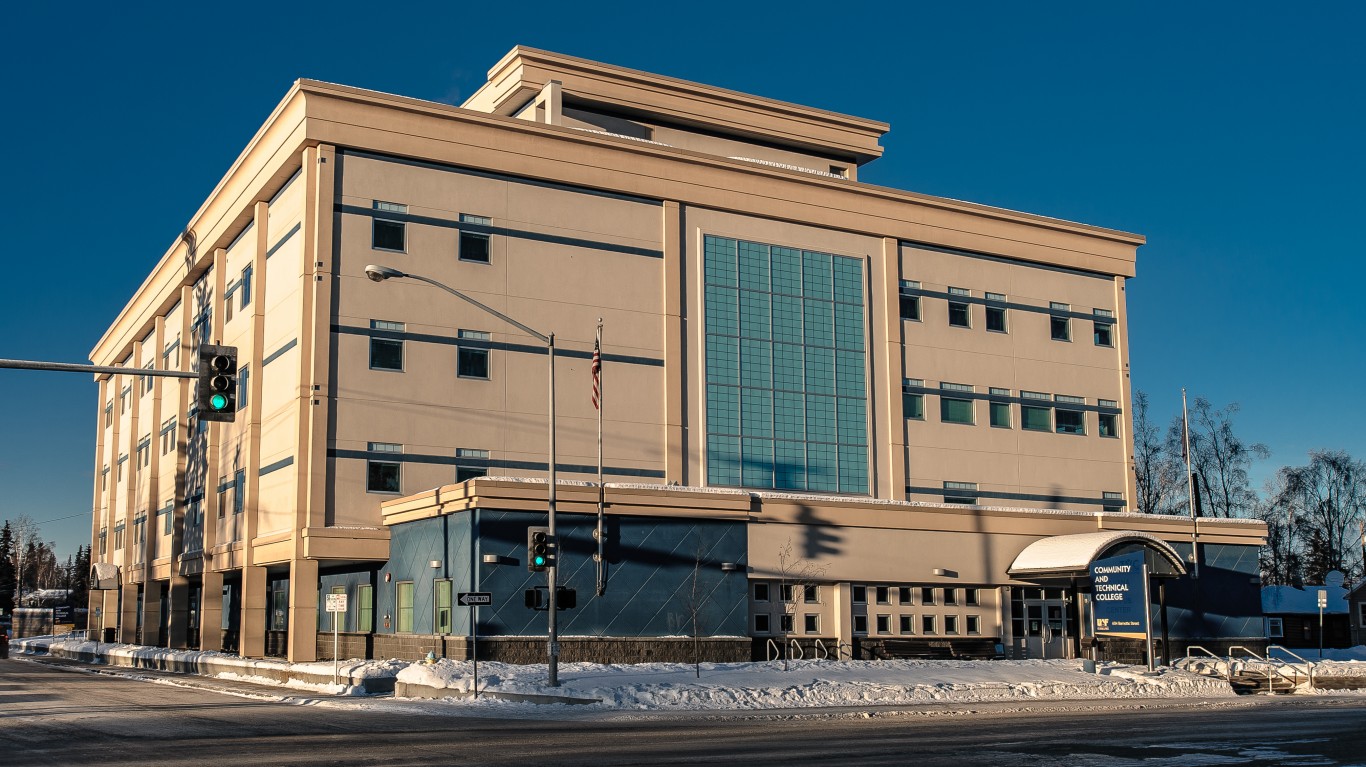
Alaska: University of Alaska Fairbanks
> Location: Fairbanks
> Acceptance rate for 2019-2020: 76.0%
> Applicants for 2019-2020: 1,383
> Median SAT score: 1160 out of 1600
> Avg. annual cost of attendance: $18,510
> Four-year undergraduate enrollment, fall 2018: 4,657
University of Alaska Fairbanks is one of just three colleges in the state of Alaska that met the qualifications to appear on this list. Though it admits over three-quarters of applications, it is still the most difficult school to get into in the state. It is also the only college in Alaska that reported a median SAT score, at 1160 out of 1600.

Arizona: Arizona State University-Tempe
> Location: Tempe
> Acceptance rate for 2019-2020: 86.5%
> Applicants for 2019-2020: 34,188
> Median SAT score: 1245 out of 1600
> Avg. annual cost of attendance: $25,621
> Four-year undergraduate enrollment, fall 2018: 42,529
Arizona State University-Tempe is one of very few large state schools to rank on this list. For every Arizona college for which there was data, the acceptance rate was well over 60%. Even though Arizona State University-Tempe has an acceptance rate of 86.5%, it still ranks as the most difficult Arizona college to get into because its median SAT score of 1245 is the highest among schools for which there is data.
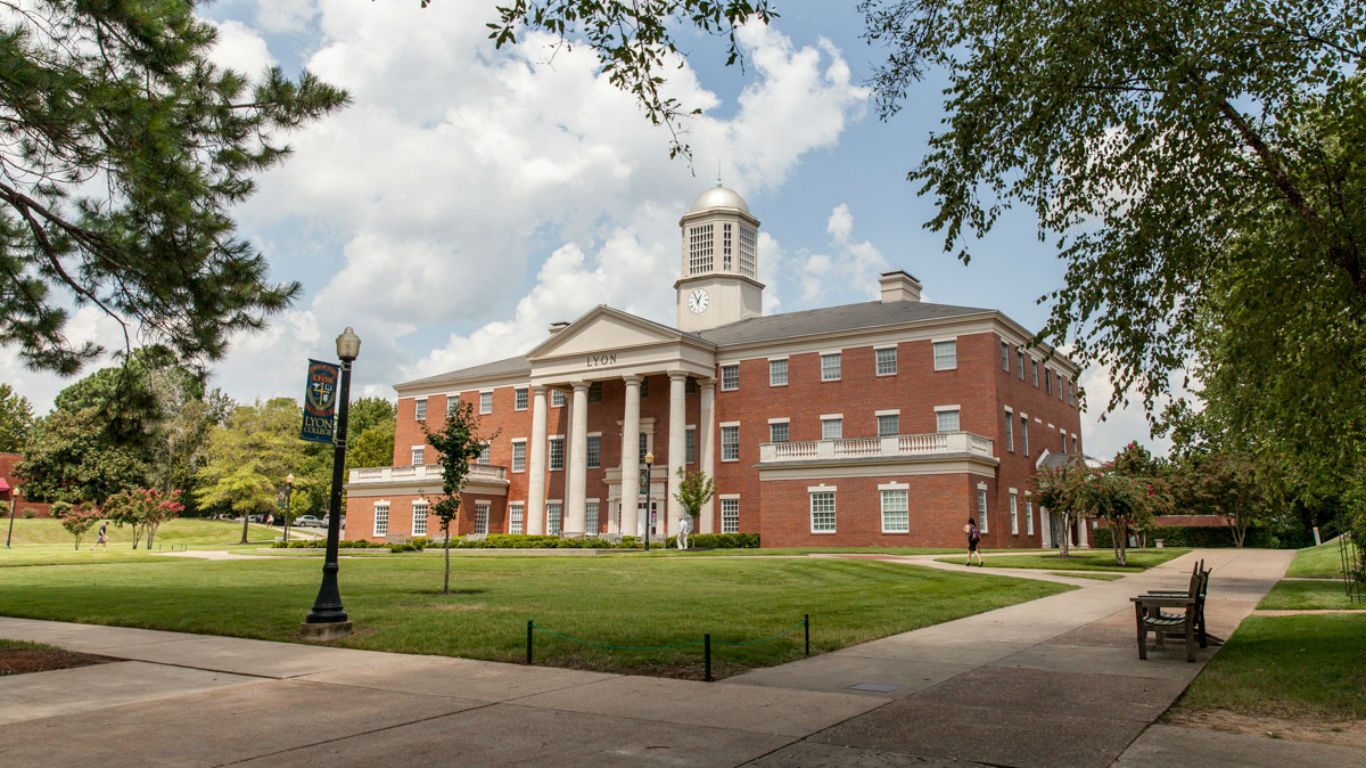
Arkansas: Lyon College
> Location: Batesville
> Acceptance rate for 2019-2020: 44.4%
> Applicants for 2019-2020: 2,394
> Median SAT score: 1114 out of 1600
> Avg. annual cost of attendance: $38,173
> Four-year undergraduate enrollment, fall 2018: 655
Lyon College in Batesville, Arkansas is one of just three colleges in the state to admit fewer than half of the students who applied for the 2019-2020 school year. Lyon College is a private liberal arts institution located in the Ozarks region of the state. It is one of the most expensive schools in the state with an average annual cost over $38,000.
[in-text-ad-2]
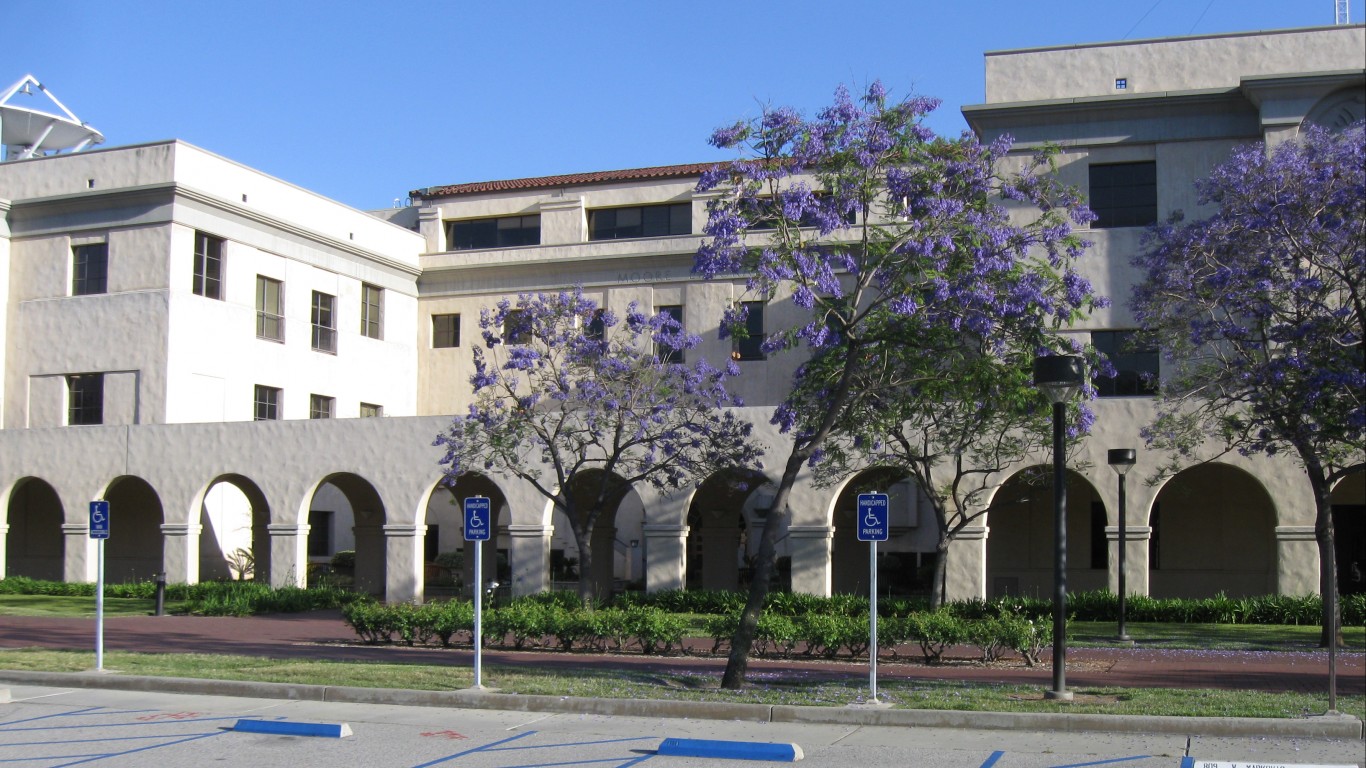
California: California Institute of Technology
> Location: Pasadena
> Acceptance rate for 2019-2020: 6.4%
> Applicants for 2019-2020: 8,367
> Median SAT score: 1555 out of 1600
> Avg. annual cost of attendance: $68,901
> Four-year undergraduate enrollment, fall 2018: 948
Of the over 1,200 higher learning institutions considered for this list, California Institute of Technology ranks not only as the hardest school to get into in its state, but the entire country — when considering both acceptance rate and median SAT scores. CalTech has one of the lowest acceptance rates in the nation, at 6.4%, and a median SAT score of 1555 — the highest of any American university. The prestigious science and engineering school has 39 Nobel laureates among its faculty and alumni and manages NASA’s Jet Propulsion Laboratory.

Colorado: United States Air Force Academy
> Location: USAF Academy
> Acceptance rate for 2019-2020: 11.1%
> Applicants for 2019-2020: 10,354
> Median SAT score: 1320 out of 1600
> Avg. annual cost of attendance: N/A
> Four-year undergraduate enrollment, fall 2018: 4,336
The United States Air Force Academy, just outside of Colorado Springs, is the only military service academy to rank as a state’s most difficult college to get into. The school accepts about one out of every nine applicants and has strict academic, physical, and moral requirements for prospective students. There is no tuition at the school, but students must serve at least five years on active duty and three as inactive reserve after graduation.
[in-text-ad]
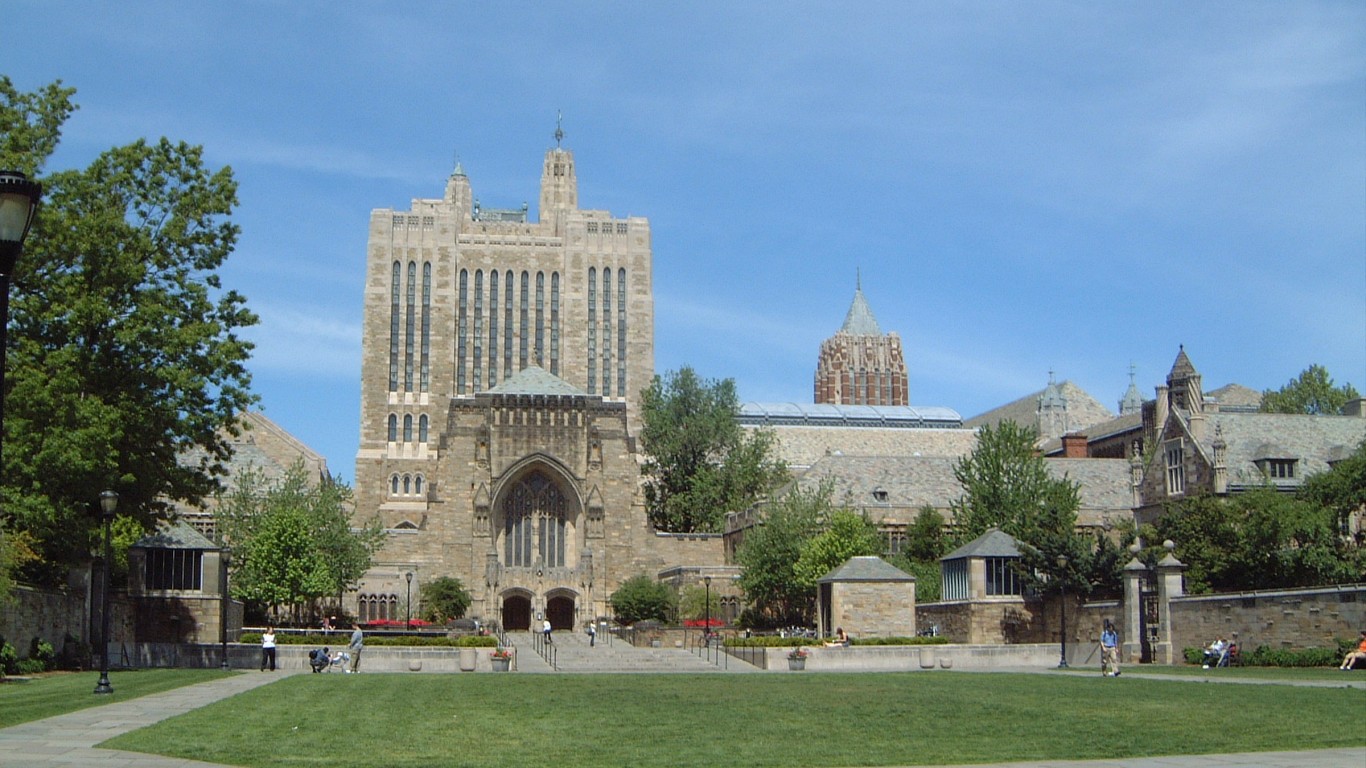
Connecticut: Yale University
> Location: New Haven
> Acceptance rate for 2019-2020: 6.1%
> Applicants for 2019-2020: 36,844
> Median SAT score: 1515 out of 1600
> Avg. annual cost of attendance: $71,290
> Four-year undergraduate enrollment, fall 2018: 5,963
Yale University is one of the most prestigious schools in the country, with five graduates having served as U.S. president. The Ivy League school has one of the 10 lowest acceptance rates among considered U.S. schools, at 6.1%. Yale also had a median SAT score of 1515 out of 1600 and a median ACT score of 34 out of 36 among students admitted in 2018.
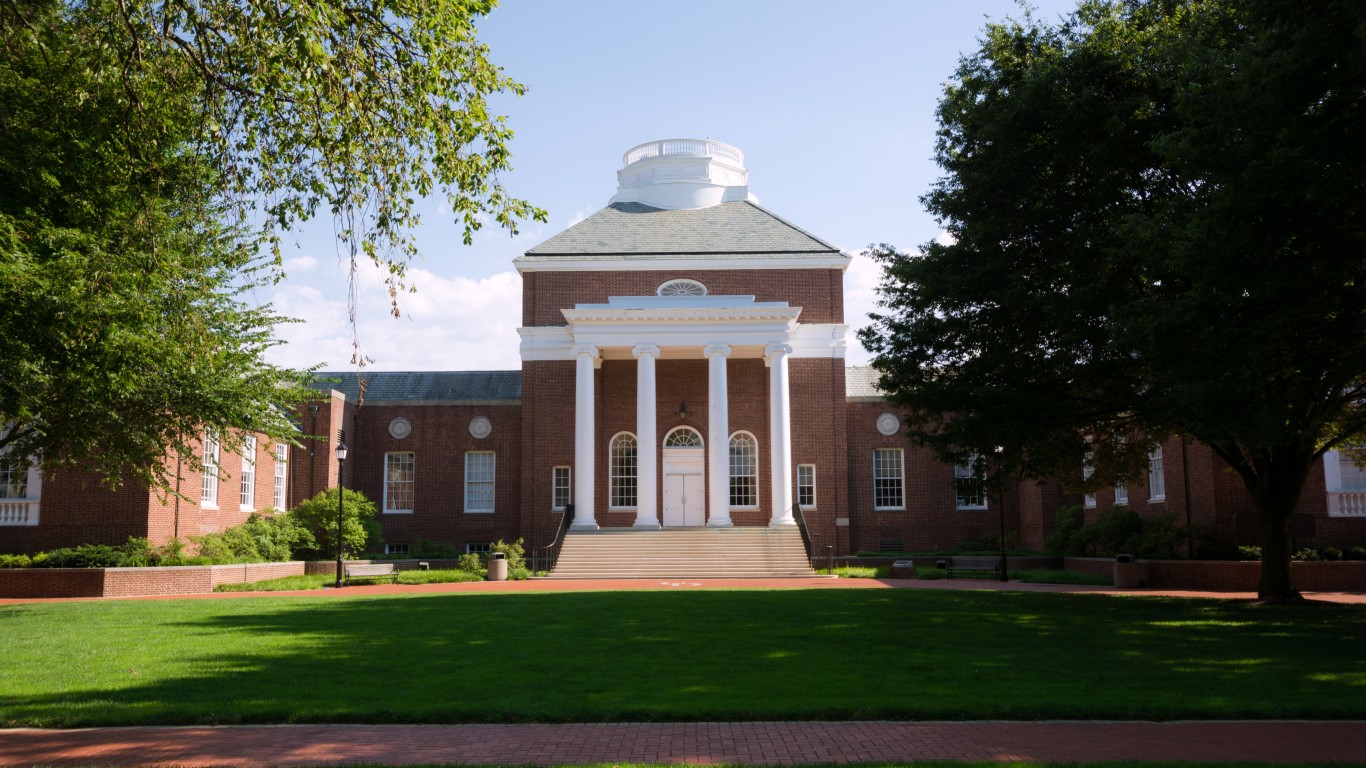
Delaware: University of Delaware
> Location: Newark
> Acceptance rate for 2019-2020: 71.4%
> Applicants for 2019-2020: 26,866
> Median SAT score: 1255 out of 1600
> Avg. annual cost of attendance: $25,584
> Four-year undergraduate enrollment, fall 2018: 19,060
The University of Delaware is one of just three institutions in the state considered for this list. Of the three, the university’s median SAT score of 1255 was by far the highest. The school, founded in 1743, is the largest university in America’s first state. Among its more notable alumni are President Joe Biden, former New Jersey Gov. Chris Christie, and actor Yvette Freeman.
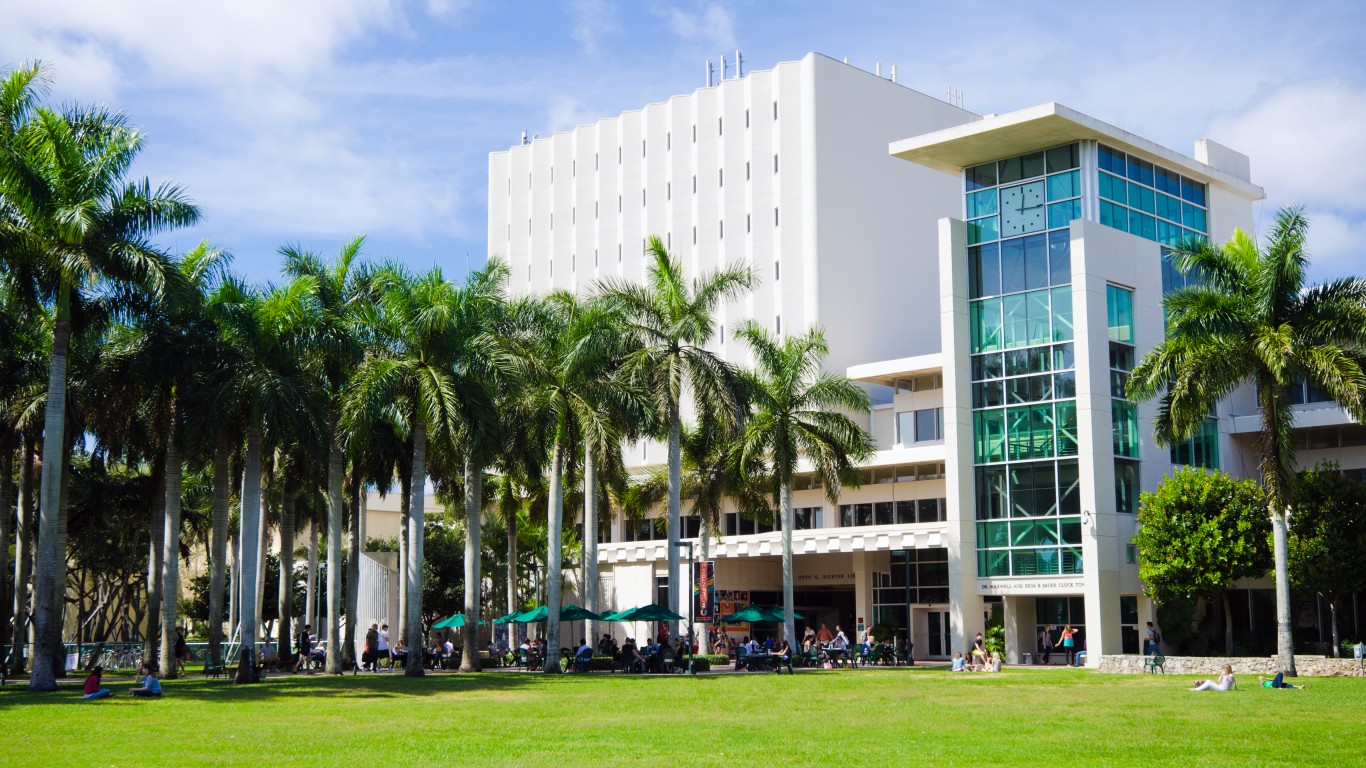
Florida: University of Miami
> Location: Coral Gables
> Acceptance rate for 2019-2020: 27.1%
> Applicants for 2019-2020: 38,920
> Median SAT score: 1340 out of 1600
> Avg. annual cost of attendance: $65,298
> Four-year undergraduate enrollment, fall 2018: 10,873
The University of Miami’s median SAT score is 1340 out of 1600 — one of the highest medians of any college in America. This high academic bar, along with a relatively low acceptance rate of 27.1%, boosted the school’s rank ahead of dozens other Florida schools and it is ranked as the hardest college to get into in the state.
[in-text-ad-2]
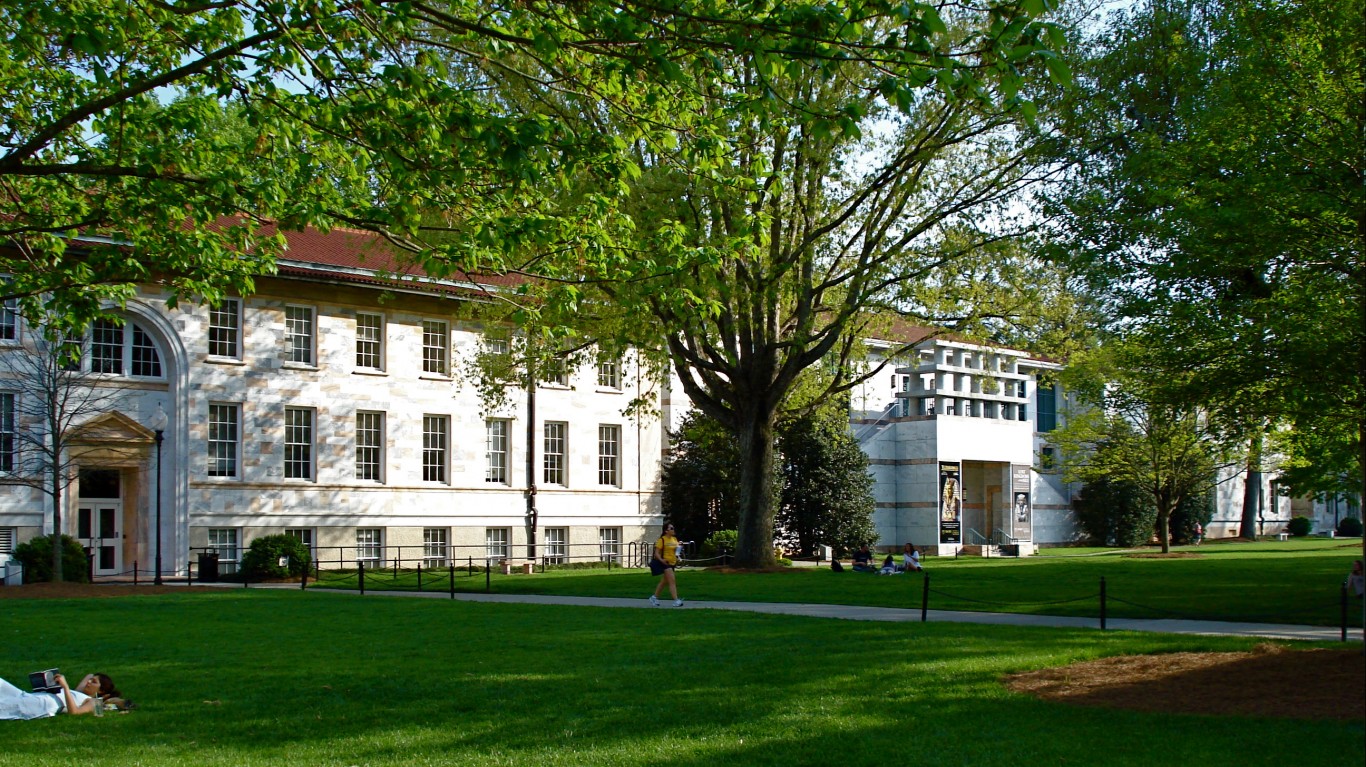
Georgia: Emory University
> Location: Atlanta
> Acceptance rate for 2019-2020: 15.6%
> Applicants for 2019-2020: 30,017
> Median SAT score: 1435 out of 1600
> Avg. annual cost of attendance: $66,950
> Four-year undergraduate enrollment, fall 2018: 6,975
Emory University is a large research college in Atlanta. It is the only one of more than 30 Georgia colleges considered for this list with an acceptance rate below 20%. The school is popular among foreign students, with 16.0% of the student body consisting of non-resident aliens. The average annual cost of attending Emory University is relatively high at nearly $67,000.

Hawaii: University of Hawaii at Manoa
> Location: Honolulu
> Acceptance rate for 2019-2020: 58.5%
> Applicants for 2019-2020: 16,235
> Median SAT score: 1145 out of 1600
> Avg. annual cost of attendance: $23,948
> Four-year undergraduate enrollment, fall 2018: 12,609
The University of Hawaii at Manoa, located in Honolulu, ranks as the hardest school in the state to get into, as its 1145 median SAT score is higher than the three other qualifying schools in Hawaii. Among all qualifying colleges in the state, University of Hawaii at Manoa students have the highest employment rate and median earnings six years after entry, at 89.6% and $35,700, respectively.
[in-text-ad]

Idaho: Boise State University
> Location: Boise
> Acceptance rate for 2019-2020: 77.4%
> Applicants for 2019-2020: 15,030
> Median SAT score: 1125 out of 1600
> Avg. annual cost of attendance: $19,573
> Four-year undergraduate enrollment, fall 2018: 16,526
Boise State University is one of just a handful of large state schools to rank as the most difficult college to get into in a state. Public schools are generally less expensive than private schools, and Boise State is one of just six schools on this list with an average annual cost of attendance under $20,000. A large research university, Boise State has over 200 fields of study for students.
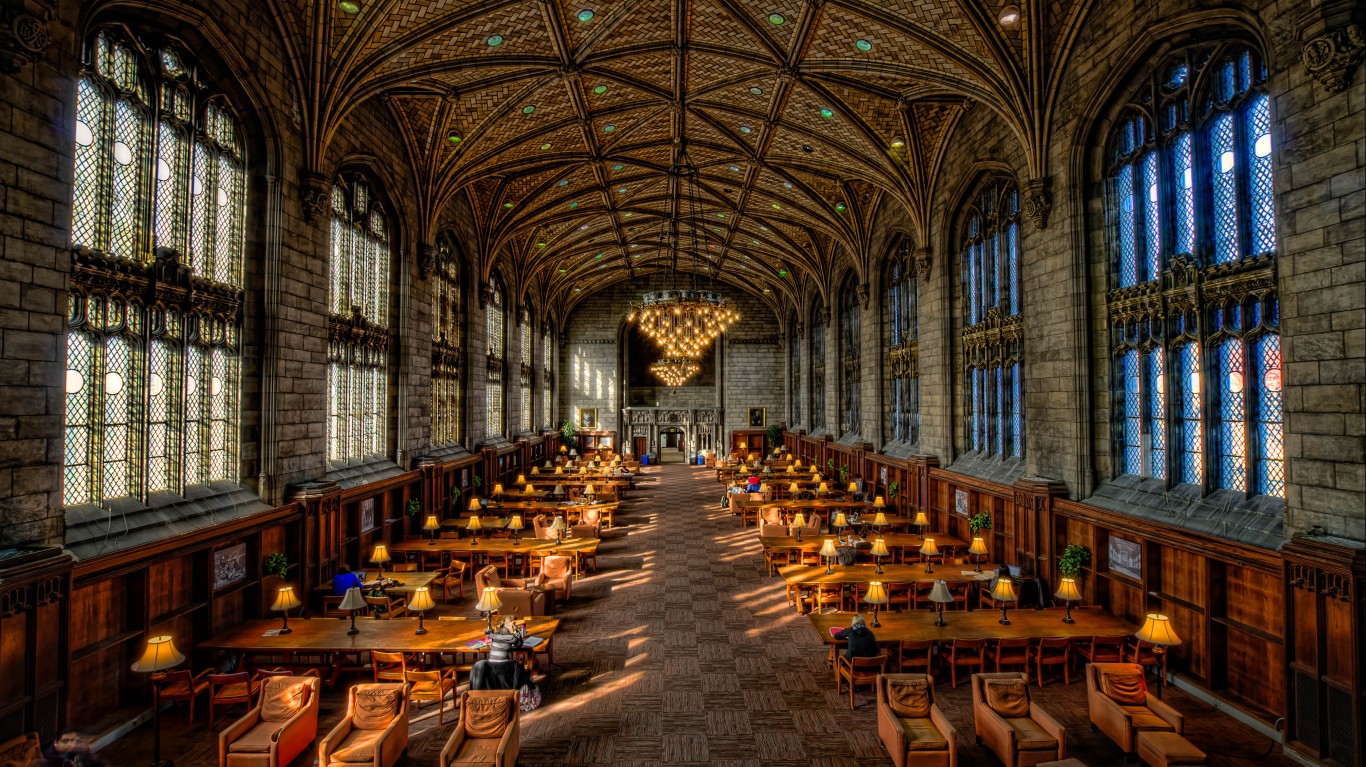
Illinois: University of Chicago
> Location: Chicago
> Acceptance rate for 2019-2020: 6.2%
> Applicants for 2019-2020: 34,641
> Median SAT score: 1520 out of 1600
> Avg. annual cost of attendance: $75,735
> Four-year undergraduate enrollment, fall 2018: 6,600
The University of Chicago is the hardest college in Illinois to get into, and the fourth hardest to get into in the country. The private college, located in Chicago’s Hyde Park neighborhood, is one of just six American colleges and universities with a median SAT score of at least 1520. Among its alumni and faculty are dozens of Nobel laureates, Pulitzer Prize winners, and Rhodes scholars.
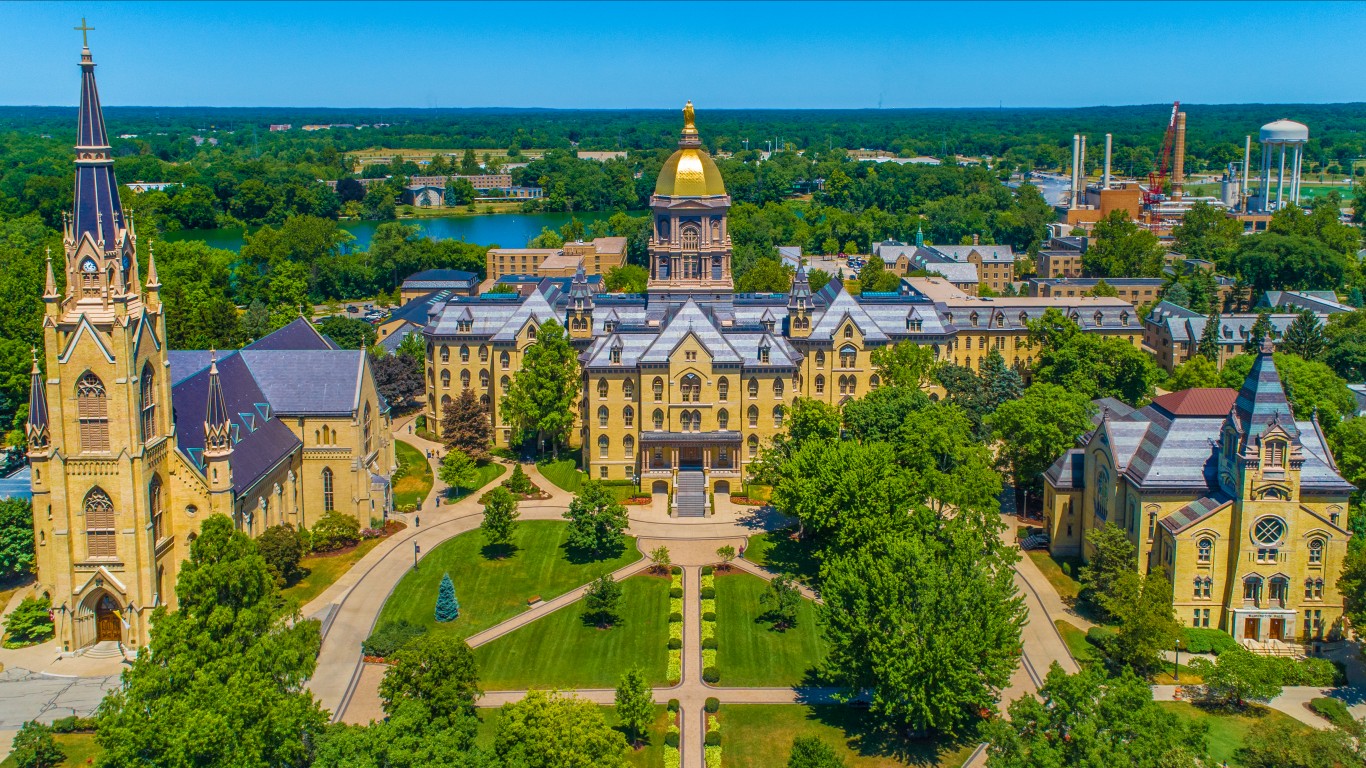
Indiana: University of Notre Dame
> Location: Notre Dame
> Acceptance rate for 2019-2020: 15.8%
> Applicants for 2019-2020: 22,200
> Median SAT score: 1475 out of 1600
> Avg. annual cost of attendance: $69,395
> Four-year undergraduate enrollment, fall 2018: 8,568
The University of Notre Dame is a private, Catholic research college located just outside of South Bend, Indiana. Notre Dame is among the more expensive colleges on this list, with an average annual cost of attendance exceeding $69,000. The tuition may be considered a good investment for some, however, as 95.2% of those who enroll in the school are employed six years later, one of the highest rates of any institution in the country. Notre Dame is known nationwide for its football team, which has won 13 national championships in the school’s history, the most recent in 1988.
[in-text-ad-2]

Iowa: Grinnell College
> Location: Grinnell
> Acceptance rate for 2019-2020: 23.1%
> Applicants for 2019-2020: 8,004
> Median SAT score: 1451 out of 1600
> Avg. annual cost of attendance: $65,814
> Four-year undergraduate enrollment, fall 2018: 1,683
Grinnell College, a small private liberal arts school in Grinnell, Iowa, describes itself as “quirky” and “curious.” The Midwestern school was founded in 1846 and is located between Iowa City and Des Moines. Its median SAT score of 1451 ranks among the best in the country, helping it rank as Iowa’s most difficult school to get into. More than 19% of undergraduate students are classified as nonresident aliens, one of the largest shares of any university in the country.

Kansas: Ottawa University-Ottawa
> Location: Ottawa
> Acceptance rate for 2019-2020: 14.5%
> Applicants for 2019-2020: 1,974
> Median SAT score: 1035 out of 1600
> Avg. annual cost of attendance: $42,254
> Four-year undergraduate enrollment, fall 2018: 706
Ottawa University is by far the most selective school in Kansas, with an acceptance rate of 14.5%. The next closest school, Sterling College, admits nearly 40% of its applicants. The private Baptist college also has a campus in Surprise, Arizona, and online classes available.
[in-text-ad]
Kentucky: Berea College
> Location: Berea
> Acceptance rate for 2019-2020: 30.3%
> Applicants for 2019-2020: 1,966
> Median SAT score: 1122 out of 1600
> Avg. annual cost of attendance: $35,394
> Four-year undergraduate enrollment, fall 2018: 1,630
Founded in 1855 and deeply rooted in Appalachian history and culture, Berea College was the first interracial and coeducational college in the South. It is also tuition free, relying on endowment income, gifts, and financial aid. All students must work at least 10 hours a week in jobs on campus and in the community.

Louisiana: Tulane University of Louisiana
> Location: New Orleans
> Acceptance rate for 2019-2020: 12.9%
> Applicants for 2019-2020: 42,185
> Median SAT score: 1420 out of 1600
> Avg. annual cost of attendance: $69,517
> Four-year undergraduate enrollment, fall 2018: 7,920
Tulane University in New Orleans was founded as a medical college in 1834 to train doctors to treat diseases such as yellow fever, malaria, and smallpox that were ravaging the port city. Tropical medicine remains one of the degrees offered at Tulane, along with architecture, business, law, liberal arts, the sciences, engineering, and social work. Tulane University received over 42,000 applications for the 2019-2020 school year, among the most of any U.S. college. It admitted less than 13% of those applicants, making it Louisiana’s most exclusive school.
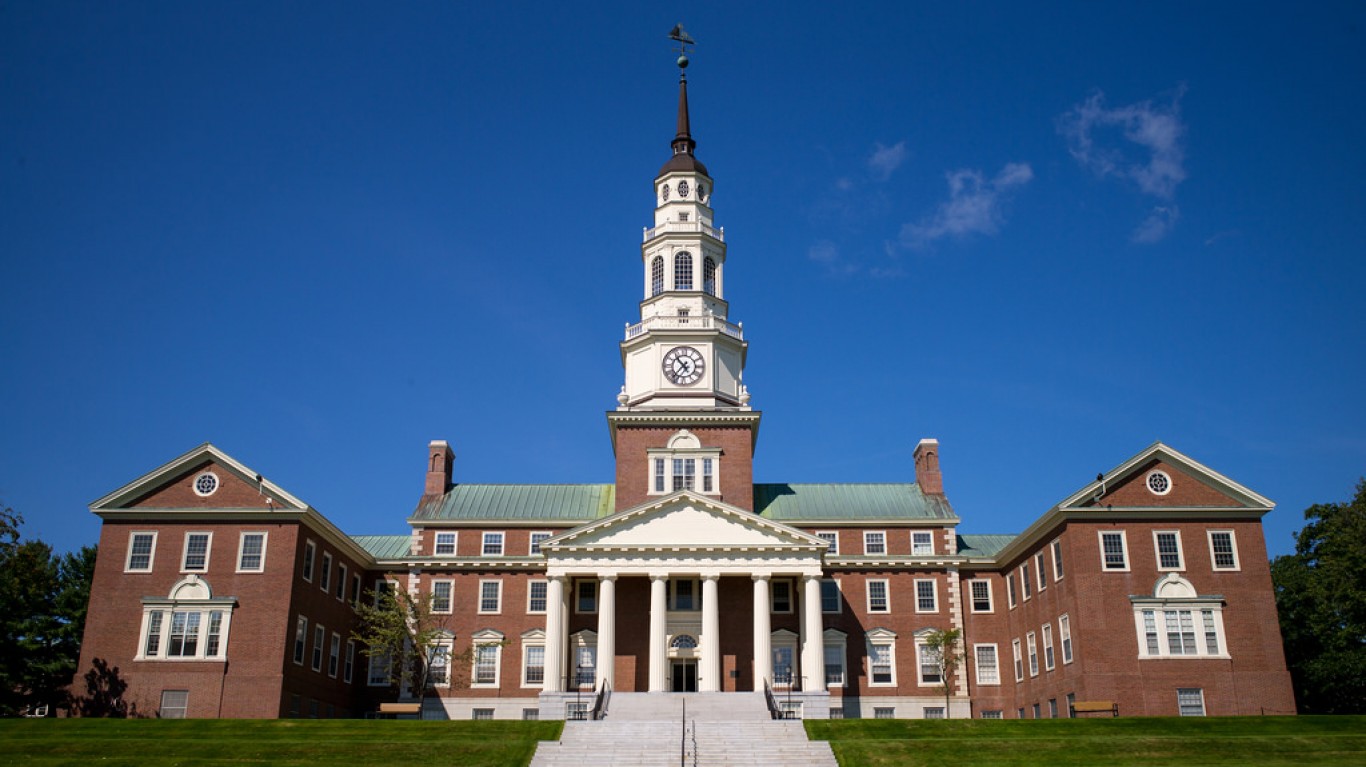
Maine: Colby College
> Location: Waterville
> Acceptance rate for 2019-2020: 9.7%
> Applicants for 2019-2020: 13,584
> Median SAT score: 1430 out of 1600
> Avg. annual cost of attendance: $68,582
> Four-year undergraduate enrollment, fall 2018: 2,000
Colby College, a private liberal arts institution founded in 1813, is located in Waterville, Maine, about 20 miles north of the state capital of Augusta. Like many other relatively selective schools, Colby College is quite expensive — the typical cost of attending the school is approximately $68,582.
[in-text-ad-2]

Maryland: Johns Hopkins University
> Location: Baltimore
> Acceptance rate for 2019-2020: 11.2%
> Applicants for 2019-2020: 31,139
> Median SAT score: 1505 out of 1600> Avg. annual cost of attendance: $69,863
> Four-year undergraduate enrollment, fall 2018: 5,567
Johns Hopkins University is one of the nation’s leading medical research schools and has served a vital role in tracking the spread of COVID-19 throughout the pandemic. The Baltimore-based university ranks as Maryland’s most difficult college to get into, with its 1505 median SAT score ranking in the top 20 of all American universities.
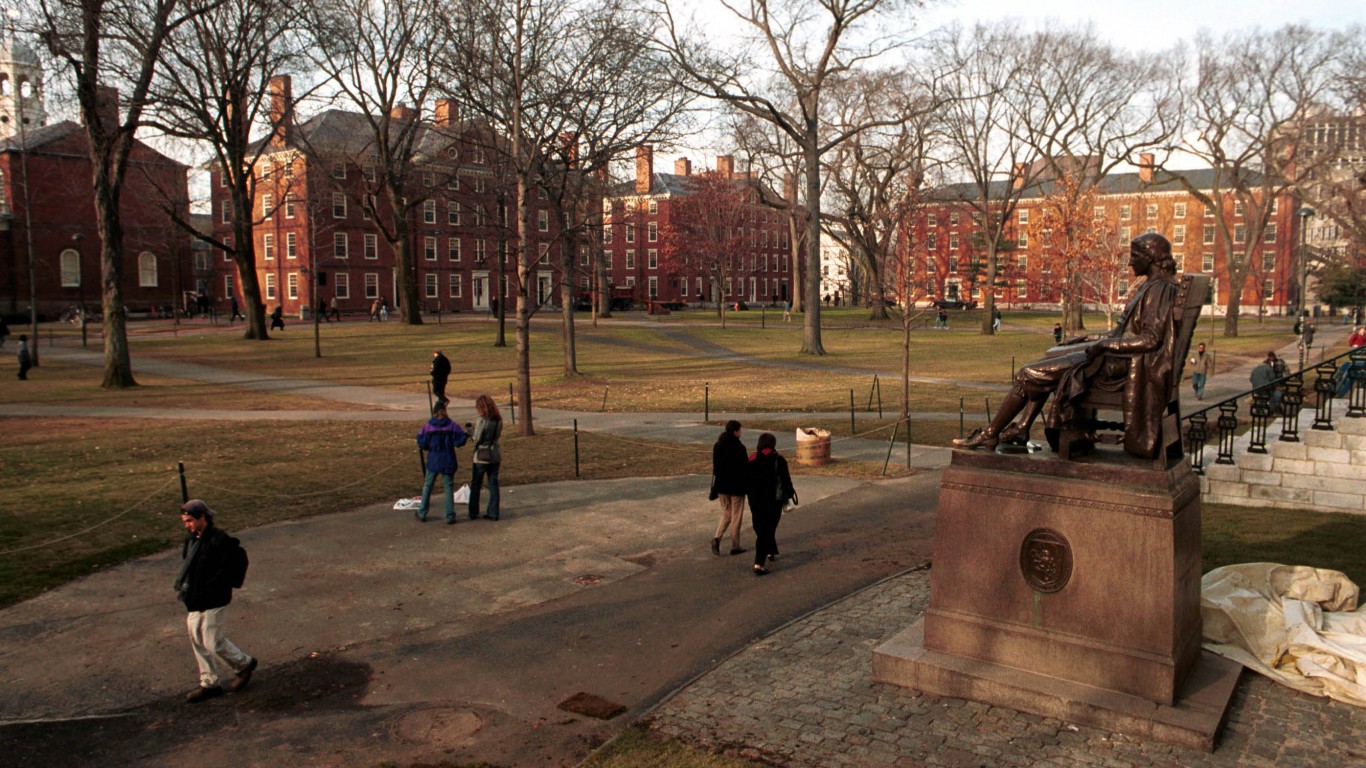
Massachusetts: Harvard University
> Location: Cambridge
> Acceptance rate for 2019-2020: 4.6%
> Applicants for 2019-2020: 43,330
> Median SAT score: 1520 out of 1600
> Avg. annual cost of attendance: $71,135
> Four-year undergraduate enrollment, fall 2018: 7,582
Harvard University is the oldest institution of higher learning in the United States, founded in 1636. Iit has produced eight presidents, more than any university, as well as dozens of Nobel laureates, heads of state, and Pulitzer Prize winners. It has the largest academic library in the world. With a 1520 median SAT score and an acceptance rate below 5%, Harvard ranks as the second most difficult school to get into in the country, behind only CalTech.
[in-text-ad]

Michigan: University of Michigan-Ann Arbor
> Location: Ann Arbor
> Acceptance rate for 2019-2020: 22.9%
> Applicants for 2019-2020: 64,972
> Median SAT score: 1420 out of 1600
> Avg. annual cost of attendance: $29,407
> Four-year undergraduate enrollment, fall 2018: 30,079
The University of Michigan-Ann Arbor is one of the largest colleges on this list, with more than 30,000 undergraduate students. Fewer than one in every four applicants were accepted for the 2019-2020 school year. The University of Michigan spends more on research than any other public university in the nation and ranks only behind Johns Hopkins University among all U.S. colleges in research expenditure.
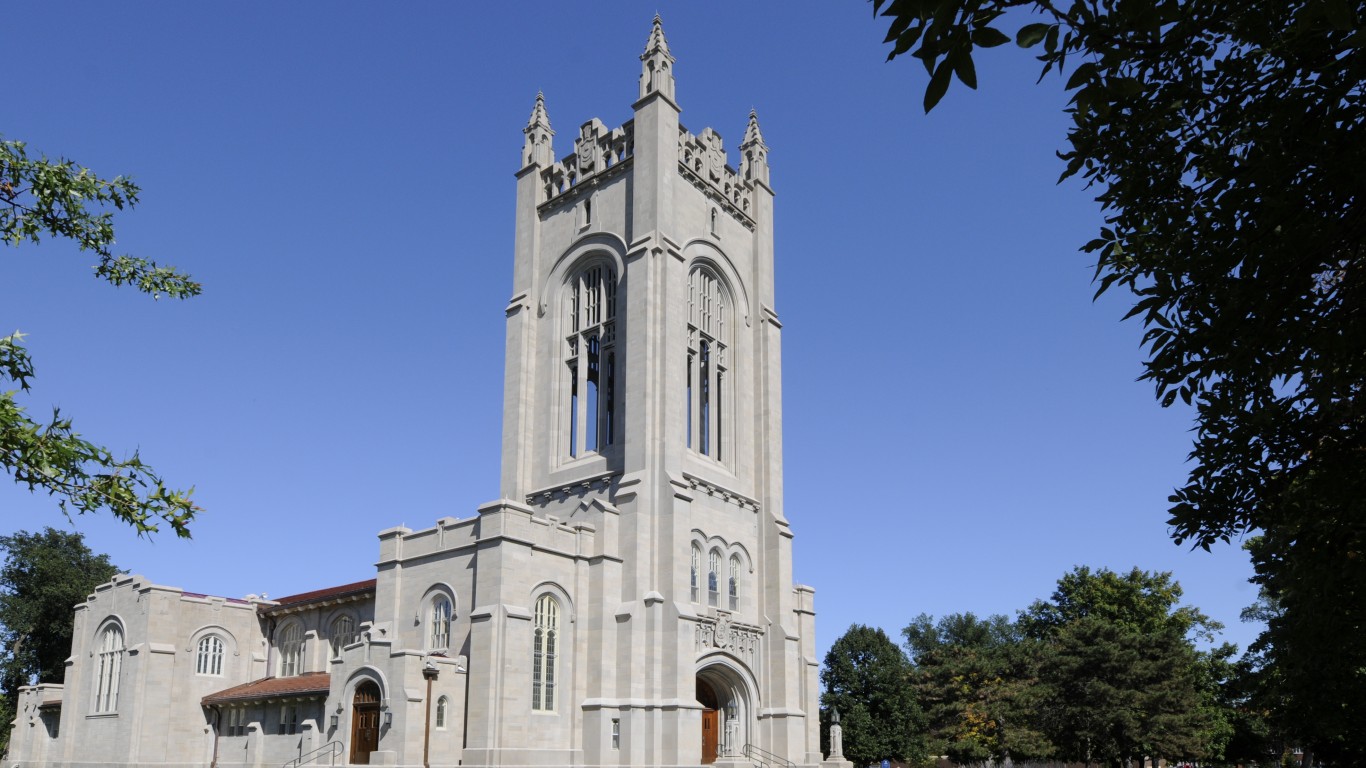
Minnesota: Carleton College
> Location: Northfield
> Acceptance rate for 2019-2020: 19.1%
> Applicants for 2019-2020: 7,324
> Median SAT score: 1440 out of 1600
> Avg. annual cost of attendance: $68,835
> Four-year undergraduate enrollment, fall 2018: 2,046
Carleton College, located in Northfield, Minnesota, about 44 miles south of Minneapolis, is a small liberal arts private school that stresses interdisciplinary scholarship. The Carleton student community is described in the Princeton Review as tight knit and supportive. Among the notable alumni are Pulitzer Prize-winning journalist Jonathan Capehart and Melvin Laird, secretary of defense under President Richard Nixon.

Mississippi: Mississippi College
> Location: Clinton
> Acceptance rate for 2019-2020: 42.0%
> Applicants for 2019-2020: 2,162
> Median SAT score: 1134 out of 1600
> Avg. annual cost of attendance: $32,102
> Four-year undergraduate enrollment, fall 2018: 3,036
Mississippi College, located in Clinton, which is about 11 miles west of the state capital of Jackson, was founded in 1826 and is the oldest institution of higher learning in Mississippi. It is affiliated with the Mississippi Baptist Convention, offering programs in the liberal arts and sciences, nursing, and business. The school’s stated vision is to be “recognized for academic excellence and commitment to the cause of Christ.”
[in-text-ad-2]

Missouri: Washington University in St Louis
> Location: Saint Louis
> Acceptance rate for 2019-2020: 13.9%
> Applicants for 2019-2020: 25,426
> Median SAT score: 1520 out of 1600
> Avg. annual cost of attendance: $71,975
> Four-year undergraduate enrollment, fall 2018: 7,356
Washington University is the hardest college in Missouri to get into, and one of the 20 hardest to get into among all American colleges. Both its median SAT score of 1520 and median ACT score of 34 rank among the highest out of all U.S. colleges. Washington University has seven degree fields for students — arts and sciences, social sciences, engineering, business, visual arts, law, and medicine. The school’s graduates tend to be well off as the median earnings of students who are working and not enrolled six years after they enter the college is $56,600 — well above the median of most other colleges.
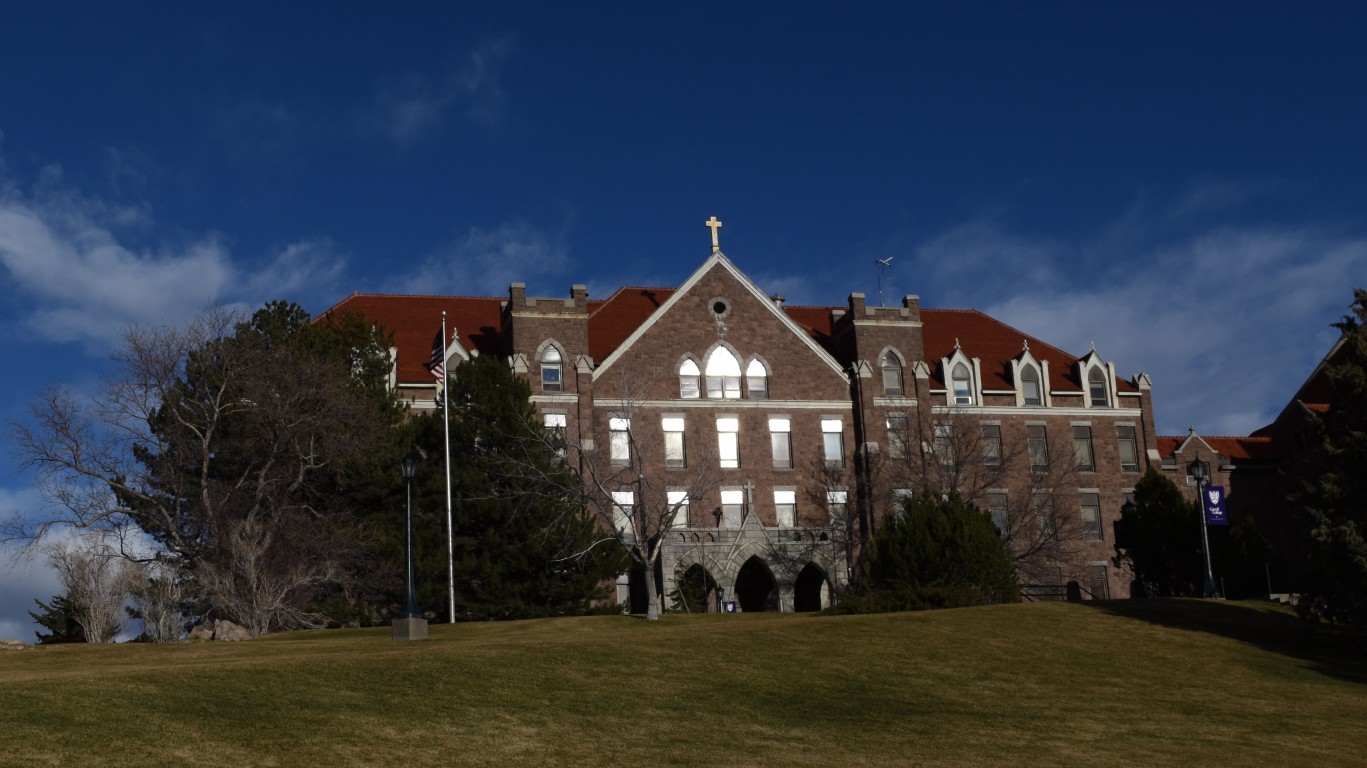
Montana: Carroll College
> Location: Helena
> Acceptance rate for 2019-2020: 68.9%
> Applicants for 2019-2020: 2,650
> Median SAT score: 1170 out of 1600
> Avg. annual cost of attendance: $48,487
> Four-year undergraduate enrollment, fall 2018: 1,210
Carroll College is a private, four-year, Catholic diocesan college in Montana’s state capital of Helena. The school admitted nearly 70% of its 2,650 applicants for the 2019-2020 school year. While this is relatively high for schools on this list, the schools’ acceptance rate and median SAT score rank it as the hardest college to get into among the state’s four colleges. Among the four qualified colleges in Montana, Carroll College is the only one in which more than 90% of former students are employed 10 years after entering the school.
[in-text-ad]
Nebraska: Creighton University
> Location: Omaha
> Acceptance rate for 2019-2020: 73.7%
> Applicants for 2019-2020: 9,381
> Median SAT score: 1250 out of 1600
> Avg. annual cost of attendance: $52,931
> Four-year undergraduate enrollment, fall 2018: 4,405
Creighton University, opened in 1878, is a Jesuit-run institution of higher education located in Omaha, Nebraska. School students have one of the highest employment rates a decade after entry, at 94.5%. As the most exclusive school in Nebraska, it is also the most expensive, with an average annual cost of attendance of nearly $53,000. No other college in the state costs even $47,000 to attend.
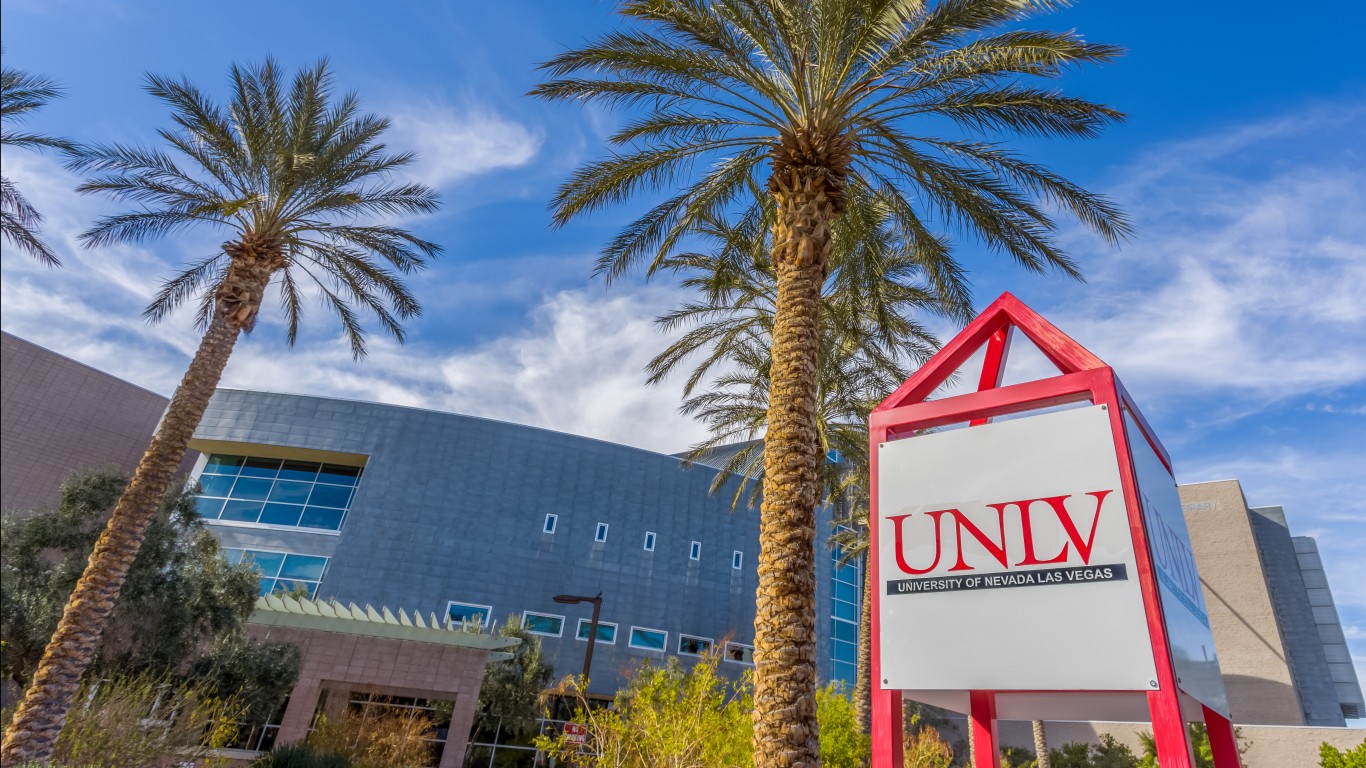
Nevada: University of Nevada-Las Vegas
> Location: Las Vegas
> Acceptance rate for 2019-2020: 80.7%
> Applicants for 2019-2020: 12,720
> Median SAT score: 1135 out of 1600
> Avg. annual cost of attendance: $17,582
> Four-year undergraduate enrollment, fall 2018: 24,707
University of Nevada-Las Vegas is one of the newer schools on the list, founded in 1957. Because the school is located in Las Vegas, not surprisingly, one of its colleges is The William F. Harrah College of Hospitality. UNLV also has schools for engineering, nursing, business, and urban affairs.

New Hampshire: Dartmouth College
> Location: Hanover
> Acceptance rate for 2019-2020: 7.9%
> Applicants for 2019-2020: 23,650
> Median SAT score: 1490 out of 1600
> Avg. annual cost of attendance: $71,827
> Four-year undergraduate enrollment, fall 2018: 4,312
Dartmouth University in Hanover is the most selective college in New Hampshire and one of seven Ivy League schools to appear on this list. In addition to having one of the most competitive undergraduate admissions, the university’s professional schools — the Geisel School of Medicine, Thayer School of Engineering, and the Tuck School of Business — are some of the most selective in the world.
[in-text-ad-2]
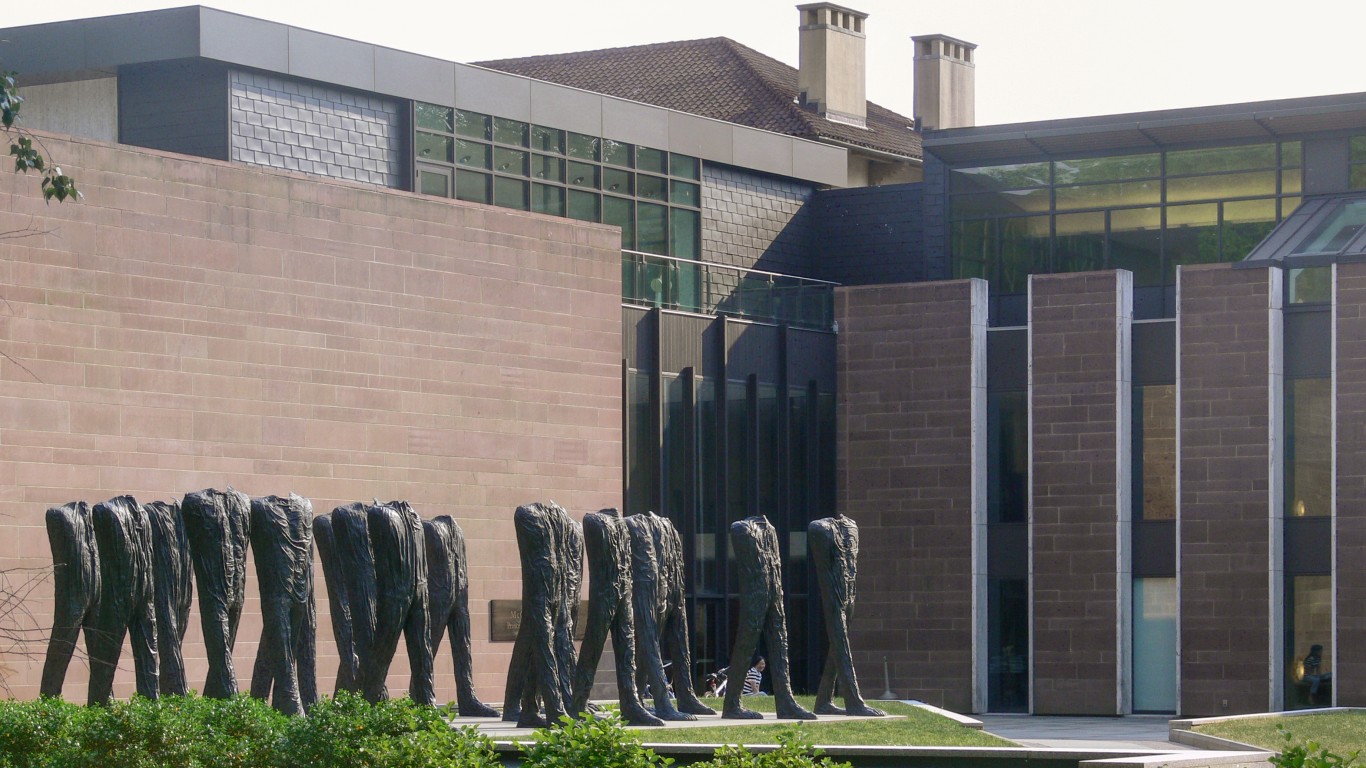
New Jersey: Princeton University
> Location: Princeton
> Acceptance rate for 2019-2020: 5.8%
> Applicants for 2019-2020: 32,804
> Median SAT score: 1505 out of 1600
> Avg. annual cost of attendance: $66,950
> Four-year undergraduate enrollment, fall 2018: 5,301
Princeton University, founded in 1746, is among the hardest schools in the country to gain admittance, considering its low acceptance rate and high median SAT score. Only a handful of other colleges have acceptance rates lower than 6%. Among Princeton’s notable alumni are U.S. presidents Woodrow Wilson and James Madison, Amazon founder and CEO Jeff Bezos, mathematician and among the developers of computer science Alan Turing, and actor James Stewart.
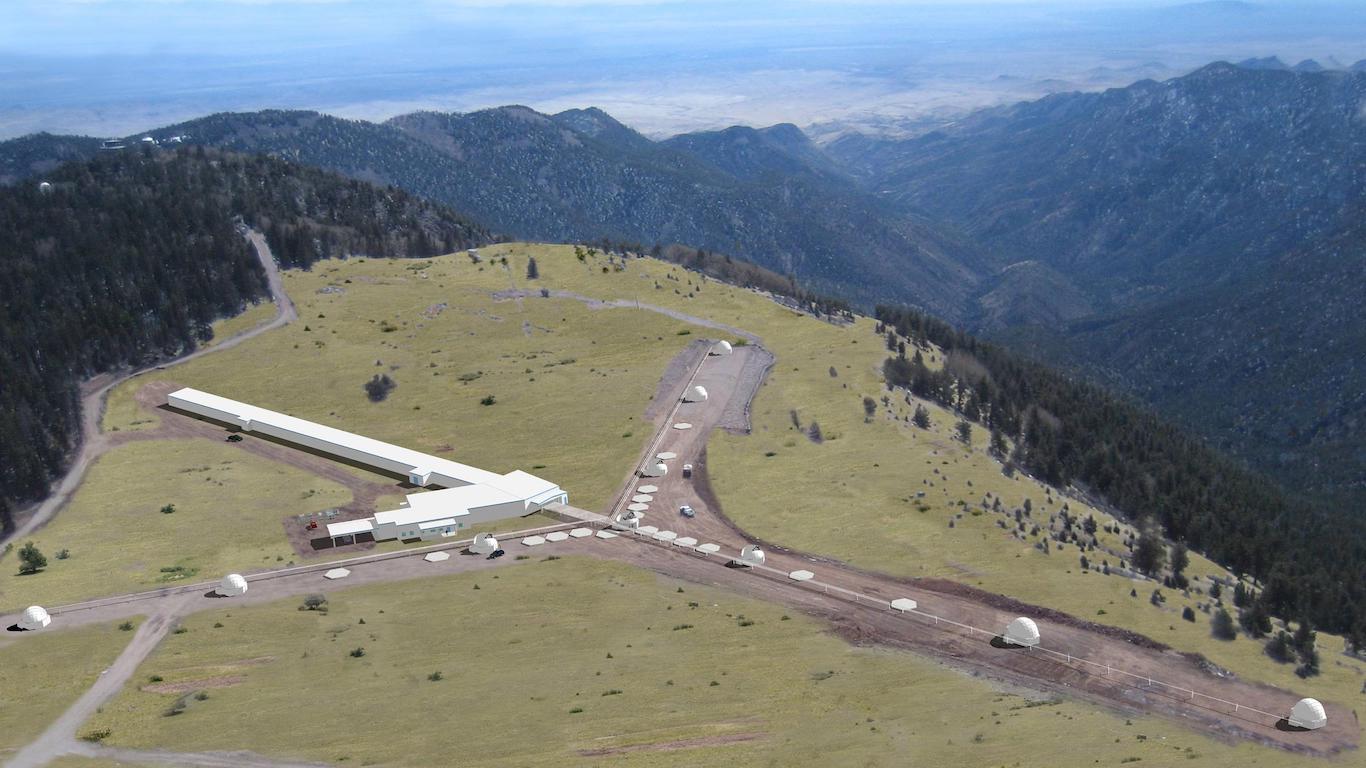
New Mexico: New Mexico Institute of Mining and Technology
> Location: Socorro
> Acceptance rate for 2019-2020: 79.8%
> Applicants for 2019-2020: 1,143
> Median SAT score: 1305 out of 1600
> Avg. annual cost of attendance: $21,244
> Four-year undergraduate enrollment, fall 2018: 1,333
The New Mexico Institute of Mining and Technology, founded in 1889 — before New Mexico became a state. It is located in the town of Socorro, about 76 miles south of Albuquerque. In addition to mining, the school offers courses of study in biology, chemistry, chemical engineering, business, and technology management. The school ranks as New Mexico’s hardest college to get into as its 1305 median SAT score is by far the highest of any school in the state for which there is data.
[in-text-ad]
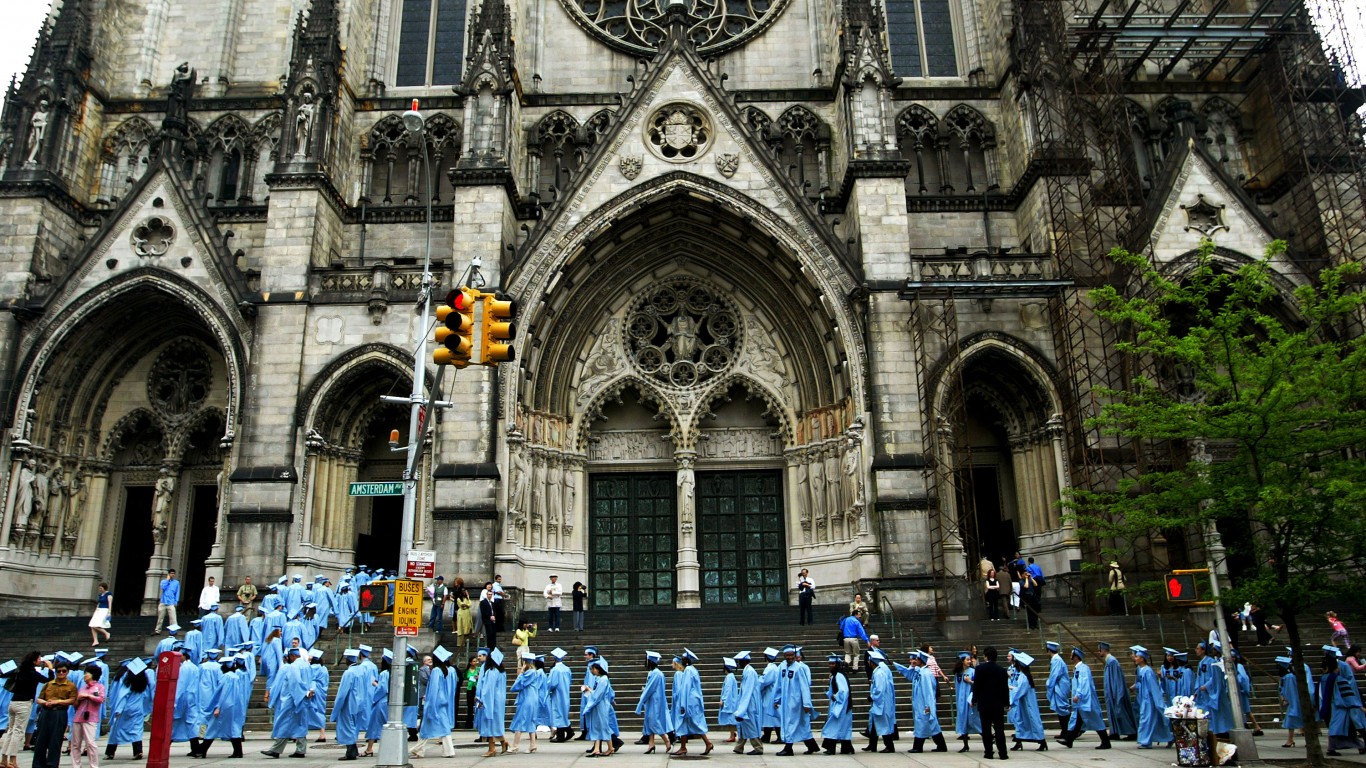
New York: Columbia University in the City of New York
> Location: New York
> Acceptance rate for 2019-2020: 5.4%
> Applicants for 2019-2020: 42,823
> Median SAT score: 1505 out of 1600
> Avg. annual cost of attendance: $74,435
> Four-year undergraduate enrollment, fall 2018: 8,216
Columbia University, one of seven Ivy League schools to feature on this list, beat out fellow Ivy League school Cornell University in Ithaca as well as over 100 other institutions to rank as New York’s most exclusive college. Columbia University, located in the Morningside Heights neighborhood of Manhattan’s Upper West Side, is one of just 14 universities in the country in which the median SAT score for students is over 1500.
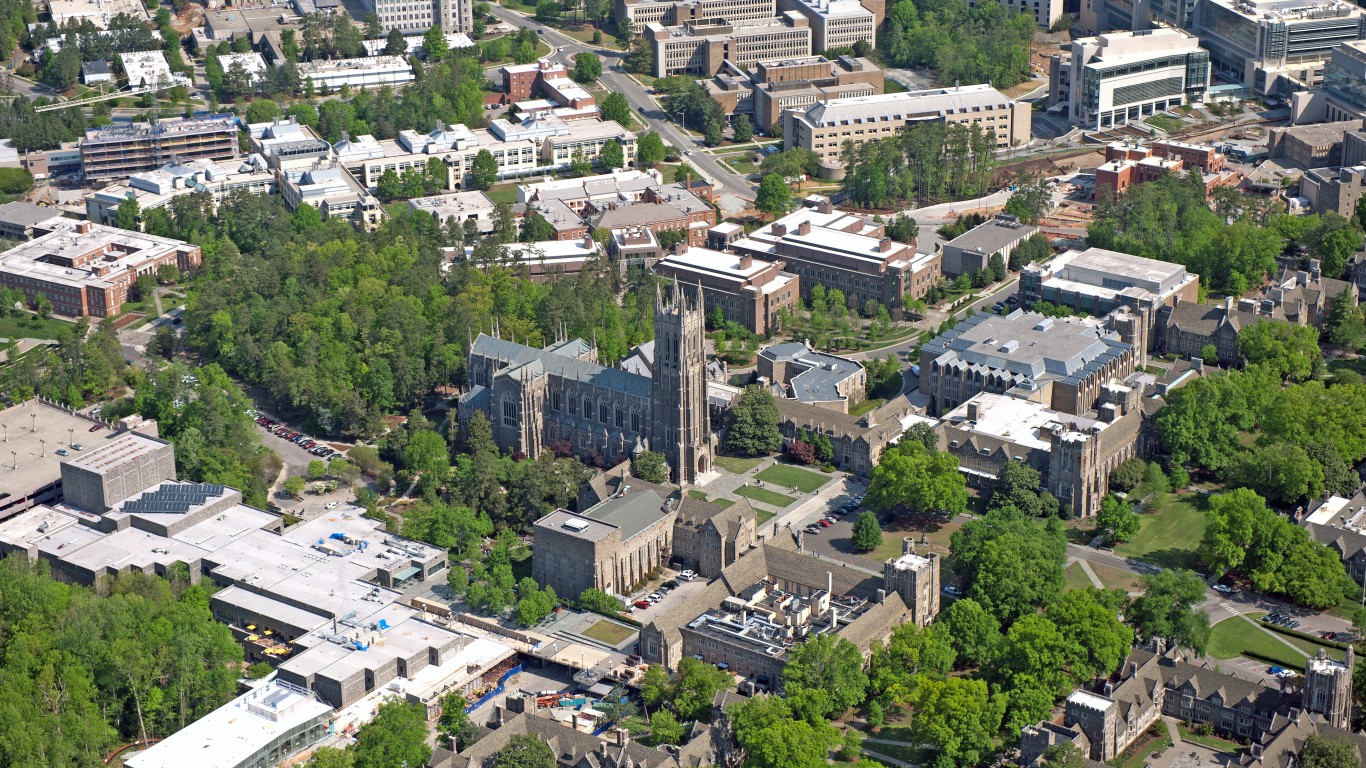
North Carolina: Duke University
> Location: Durham
> Acceptance rate for 2019-2020: 7.6%
> Applicants for 2019-2020: 41,947
> Median SAT score: 1510 out of 1600
> Avg. annual cost of attendance: $72,466
> Four-year undergraduate enrollment, fall 2018: 6,596
Duke University is one of North Carolina’s three prestigious research colleges that make up the region’s Research Triangle. But with an acceptance rate of just 7.6% and a median SAT score of 1510, Duke University stands out as the hardest school to get into in the state and one of the 10 most exclusive schools in the nation. Duke students have median earnings of over $76,000 six years after entering the school — one of the highest such figures of any school in the country.
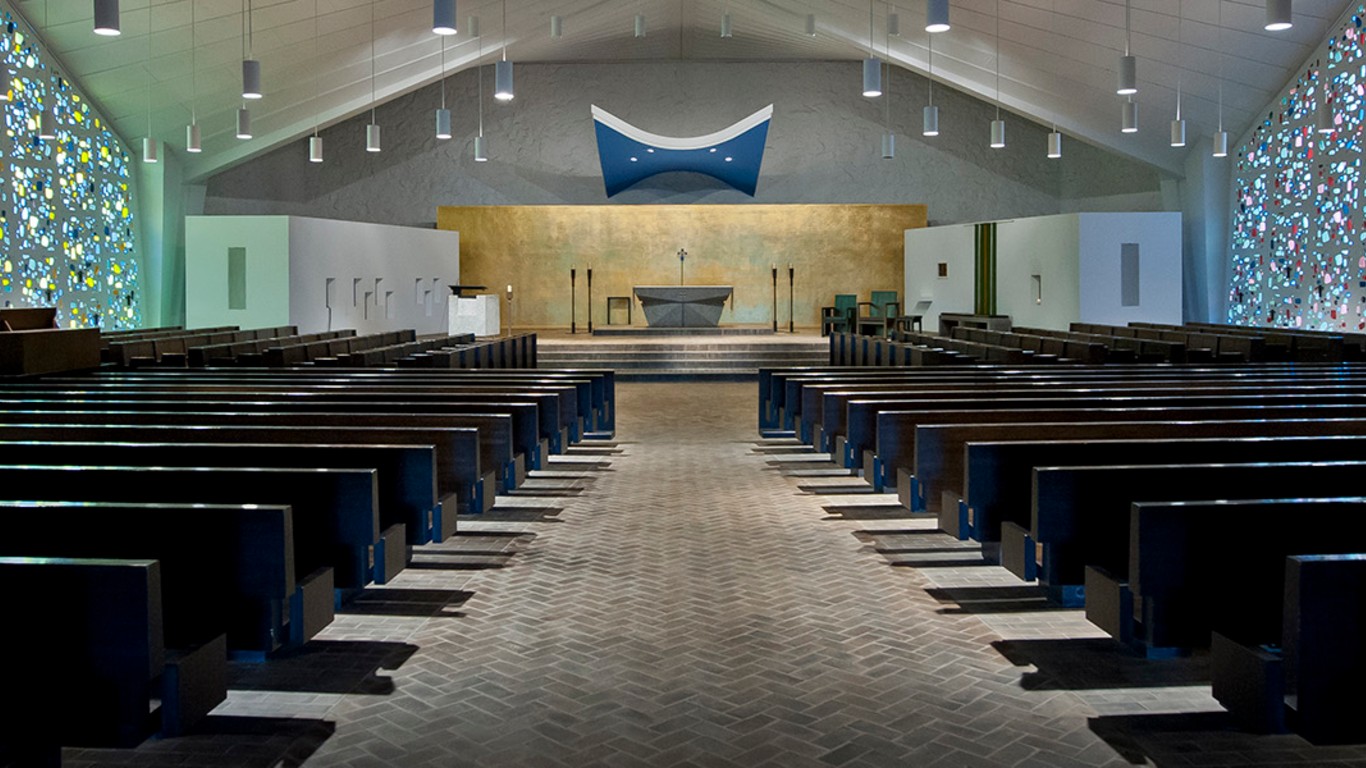
North Dakota: University of Mary
> Location: Bismarck
> Acceptance rate for 2019-2020: 73.5%
> Applicants for 2019-2020: 1,376
> Median SAT score: 1160 out of 1600
> Avg. annual cost of attendance: $28,472
> Four-year undergraduate enrollment, fall 2018: 2,169
The University of Mary is a private Catholic college in Bismarck, North Dakota. It edged out three other colleges in the state to rank as the state’s hardest college to get into, even though it admitted nearly three-quarters of applicants. Among all qualified North Dakota colleges, University of Mary has the highest median earnings among students working and not enrolled six years after entry, at $44,300. It also has one of the country’s highest employment rates 10 years after entry at 93.8%.
[in-text-ad-2]
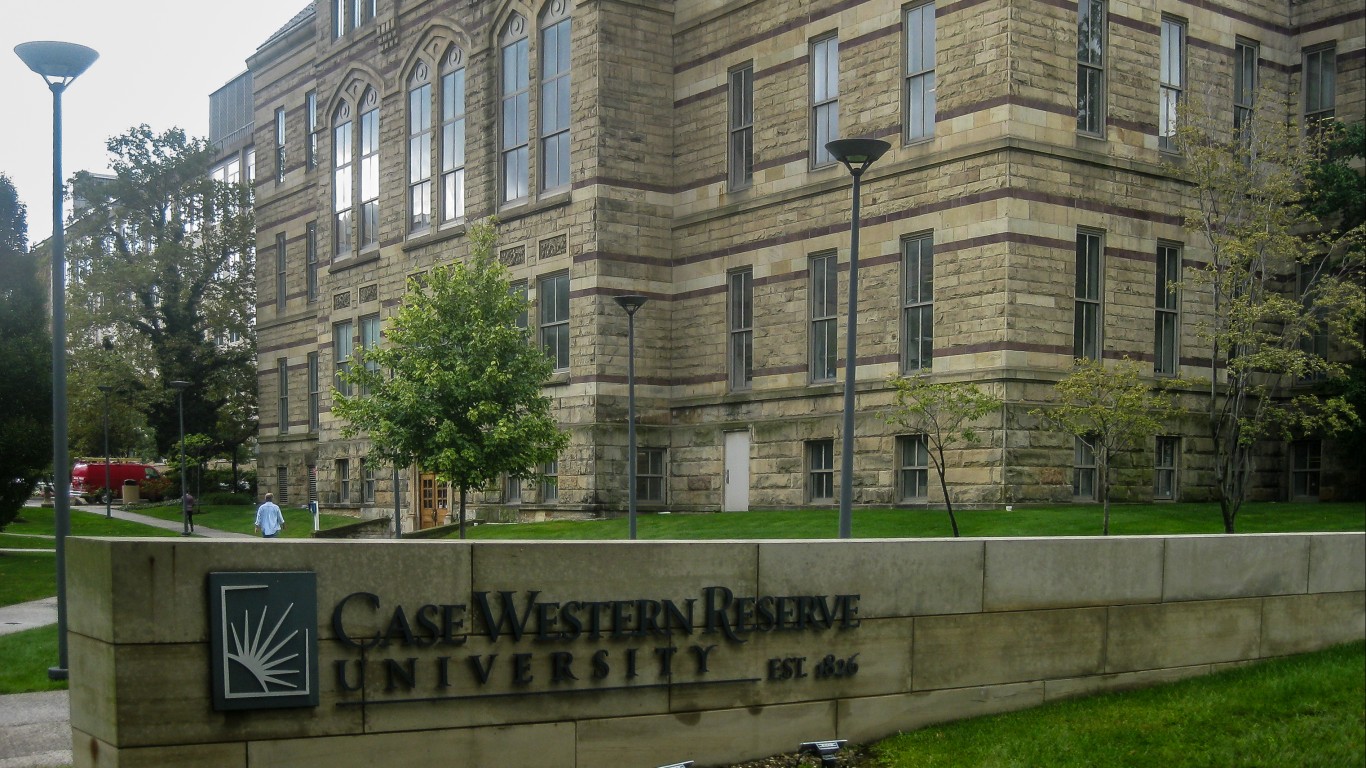
Ohio: Case Western Reserve University
> Location: Cleveland
> Acceptance rate for 2019-2020: 27.4%
> Applicants for 2019-2020: 28,786
> Median SAT score: 1435 out of 1600
> Avg. annual cost of attendance: $67,083
> Four-year undergraduate enrollment, fall 2018: 5,131
Case Western Reserve University is a private research college located in Cleveland. The school reported over $330 million in sponsored research across over 1,200 projects in 2019. Like many other private schools on this list, Case Western Reserve University is relatively expensive. It ranks as one of the nation’s 100 most expensive schools, with an average annual cost of attendance over $67,000.

Oklahoma: University of Tulsa
> Location: Tulsa
> Acceptance rate for 2019-2020: 35.8%
> Applicants for 2019-2020: 9,793
> Median SAT score: 1295 out of 1600
> Avg. annual cost of attendance: $56,906
> Four-year undergraduate enrollment, fall 2018: 3,246
The University of Tulsa, founded in 1894, is a private institution known for its petroleum engineering programs, which are taught in a facility that features a drilling simulator. University of Tulsa is by far the most selective college in Oklahoma, admitting fewer than 36% of applicants. Every other qualifying school in the state has an acceptance rate of over 50%. Tulsa also boasts the highest median SAT scores of any Oklahoma college at 1295.
[in-text-ad]
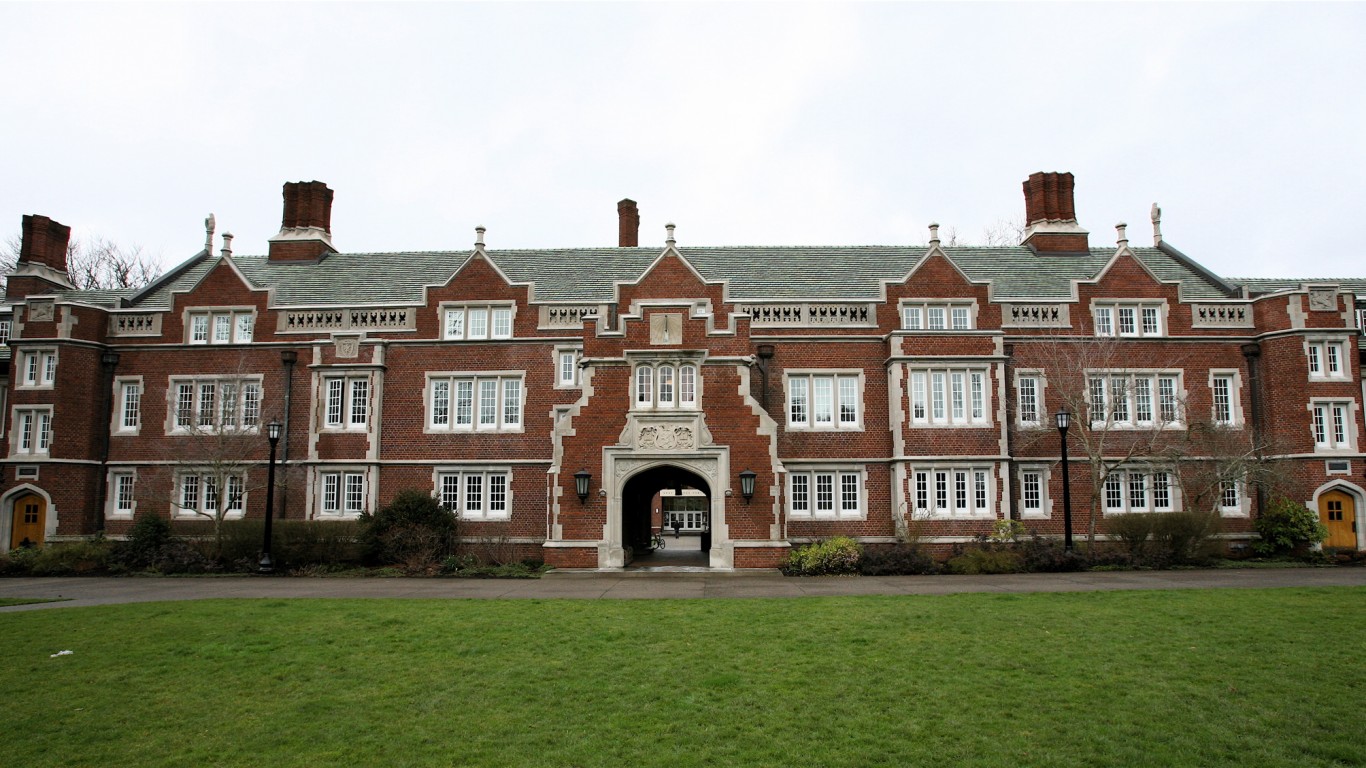
Oregon: Reed College
> Location: Portland
> Acceptance rate for 2019-2020: 39.5%
> Applicants for 2019-2020: 5,815
> Median SAT score: 1415 out of 1600
> Avg. annual cost of attendance: $69,734
> Four-year undergraduate enrollment, fall 2018: 1,456
Reed College, located in Portland, Oregon, is a small private liberal arts college that was founded in 1908. It stands apart from all other colleges in Oregon in its selectivity. Reed College admits fewer than 40% of applicants, while all other colleges in the state have acceptance rates over 57%. Reed’s median SAT score of 1415 out of 1600 is also by far the highest in the state.
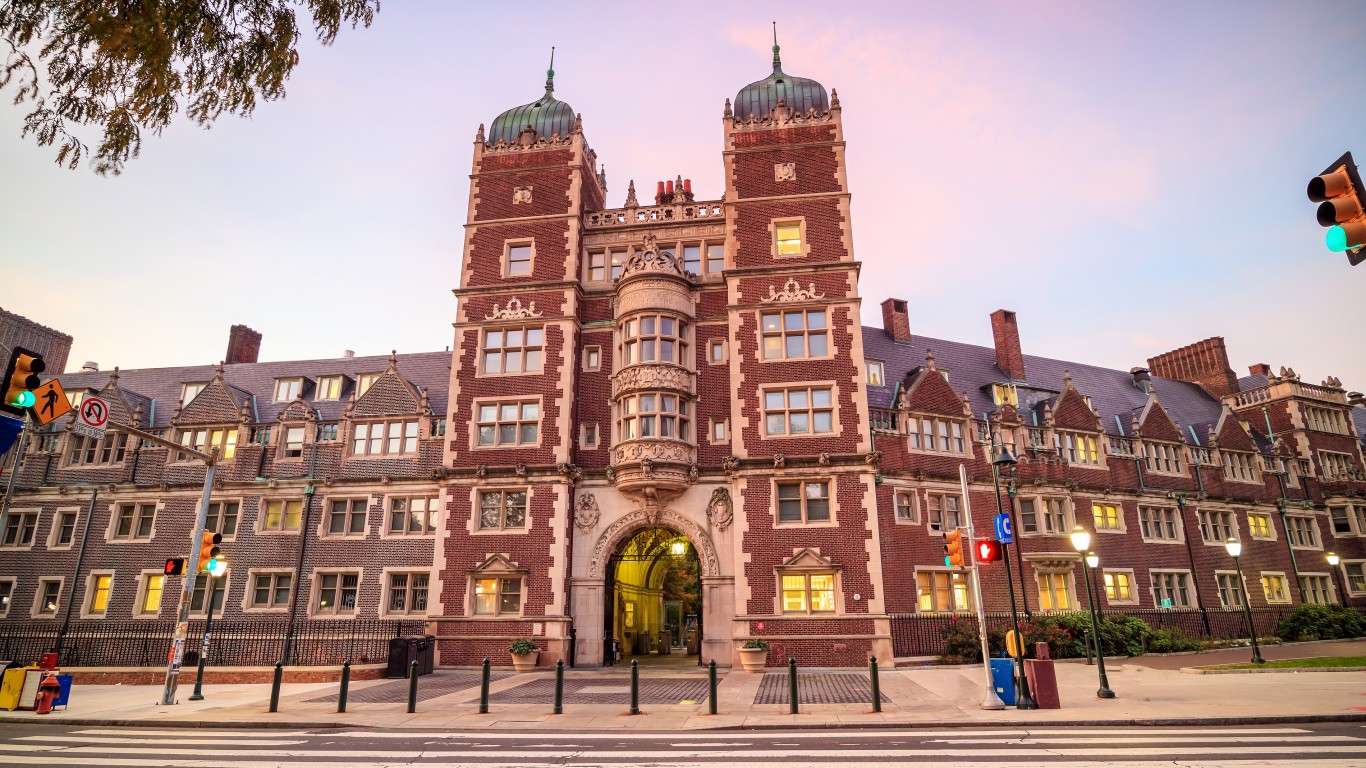
Pennsylvania: University of Pennsylvania
> Location: Philadelphia
> Acceptance rate for 2019-2020: 7.7%
> Applicants for 2019-2020: 44,961
> Median SAT score: 1485 out of 1600
> Avg. annual cost of attendance: $72,584
> Four-year undergraduate enrollment, fall 2018: 10,764
The University of Pennsylvania is another of the Ivy League schools founded in Colonial times, in 1740 by Benjamin Franklin. According to the Princeton Review, students laud the university for its combination of urban setting and a traditional college campus. Considering its acceptance rate and median SAT score, UPenn ranks among the 20 hardest colleges in the nation to get into.
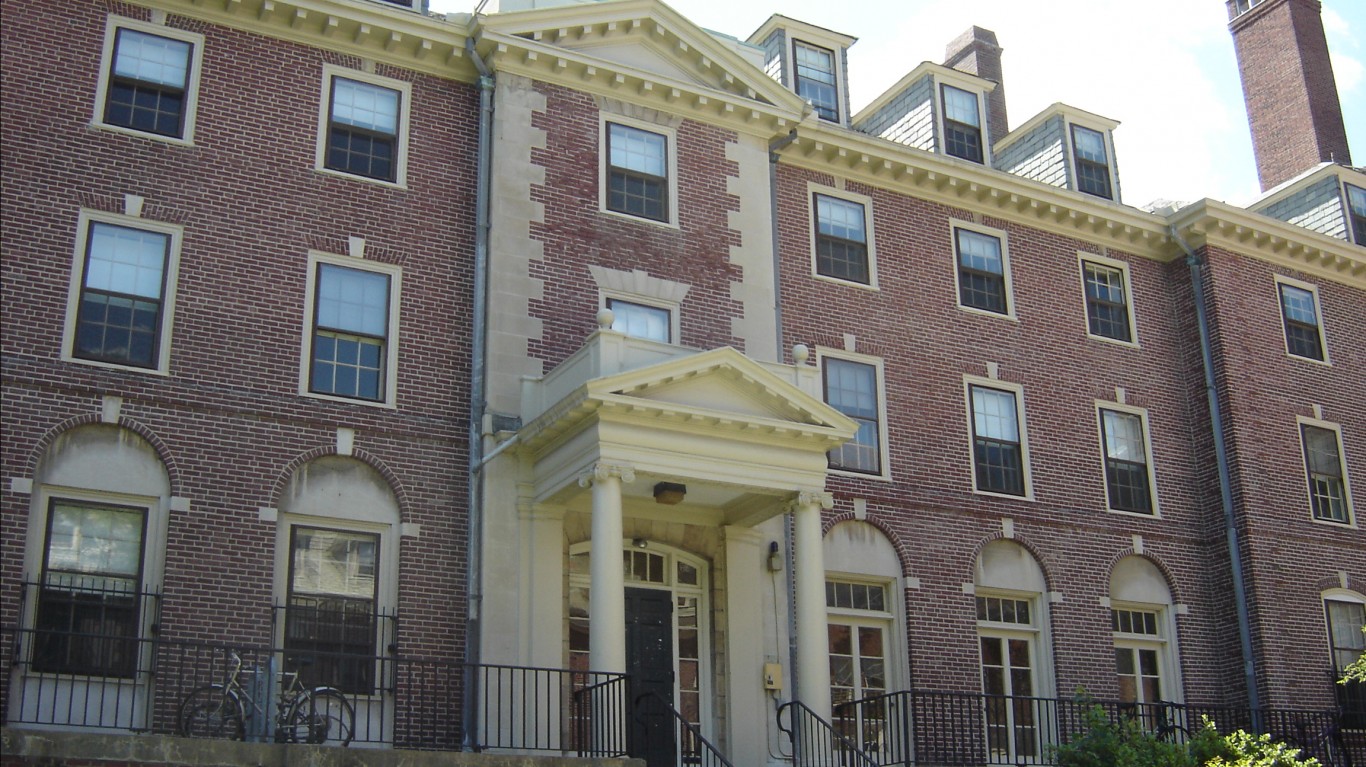
Rhode Island: Brown University
> Location: Providence
> Acceptance rate for 2019-2020: 7.1%
> Applicants for 2019-2020: 38,674
> Median SAT score: 1485 out of 1600
> Avg. annual cost of attendance: $71,050
> Four-year undergraduate enrollment, fall 2018: 6,752
Ivy League schools are the hardest colleges to get into in their respective states, and Brown University in Providence, Rhode Island, is among them. Brown students design their own courses of study. Brown’s English and history programs are well regarded, as is its Warren Alpert Medical School. Business moguls John D. Rockefeller Jr. and Ted Turner are Brown alumni.
[in-text-ad-2]

South Carolina: Clemson University
> Location: Clemson
> Acceptance rate for 2019-2020: 51.3%
> Applicants for 2019-2020: 29,070
> Median SAT score: 1310 out of 1600
> Avg. annual cost of attendance: $29,499
> Four-year undergraduate enrollment, fall 2018: 19,564
Clemson University’s profile has been raised in recent years by the success of its football program, which has won two national championships recently. Commonly chosen majors at Clemson, founded in 1889, range from accounting to youth development. Clemson is one of just two qualified South Carolina universities with a median SAT score of over 1300.
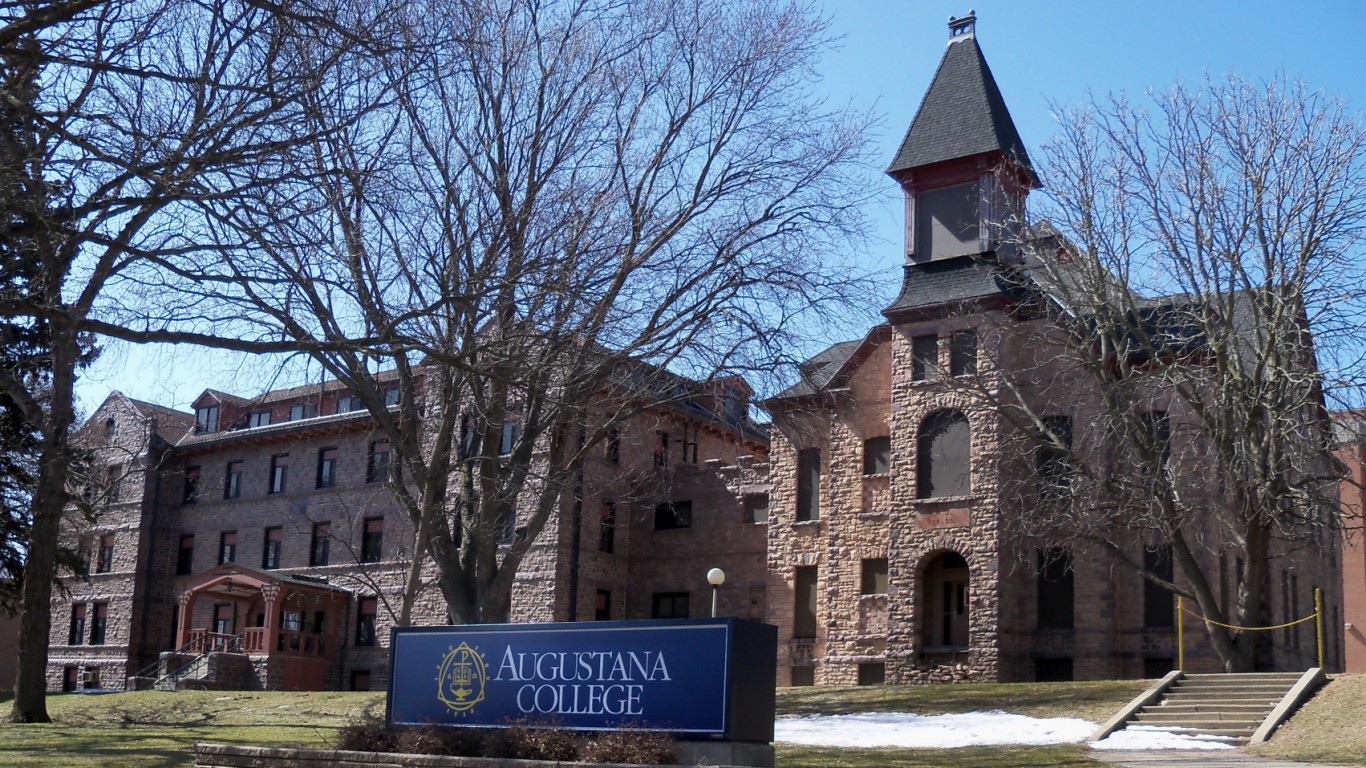
South Dakota: Augustana University
> Location: Sioux Falls
> Acceptance rate for 2019-2020: 66.9%
> Applicants for 2019-2020: 2,224
> Median SAT score: 1195 out of 1600
> Avg. annual cost of attendance: $45,145
> Four-year undergraduate enrollment, fall 2018: 1,752
Augustana College, located at Sioux Falls, South Dakota, is a private liberal arts school affiliated with the Lutheran Church. Students at the school can choose from over 100 possible majors, like biochemistry, data science, business, and more. The school was founded in 1860, before South Dakota became a state. Augustana University is the only school in South Dakota to accept fewer than 70% of applicants.
[in-text-ad]
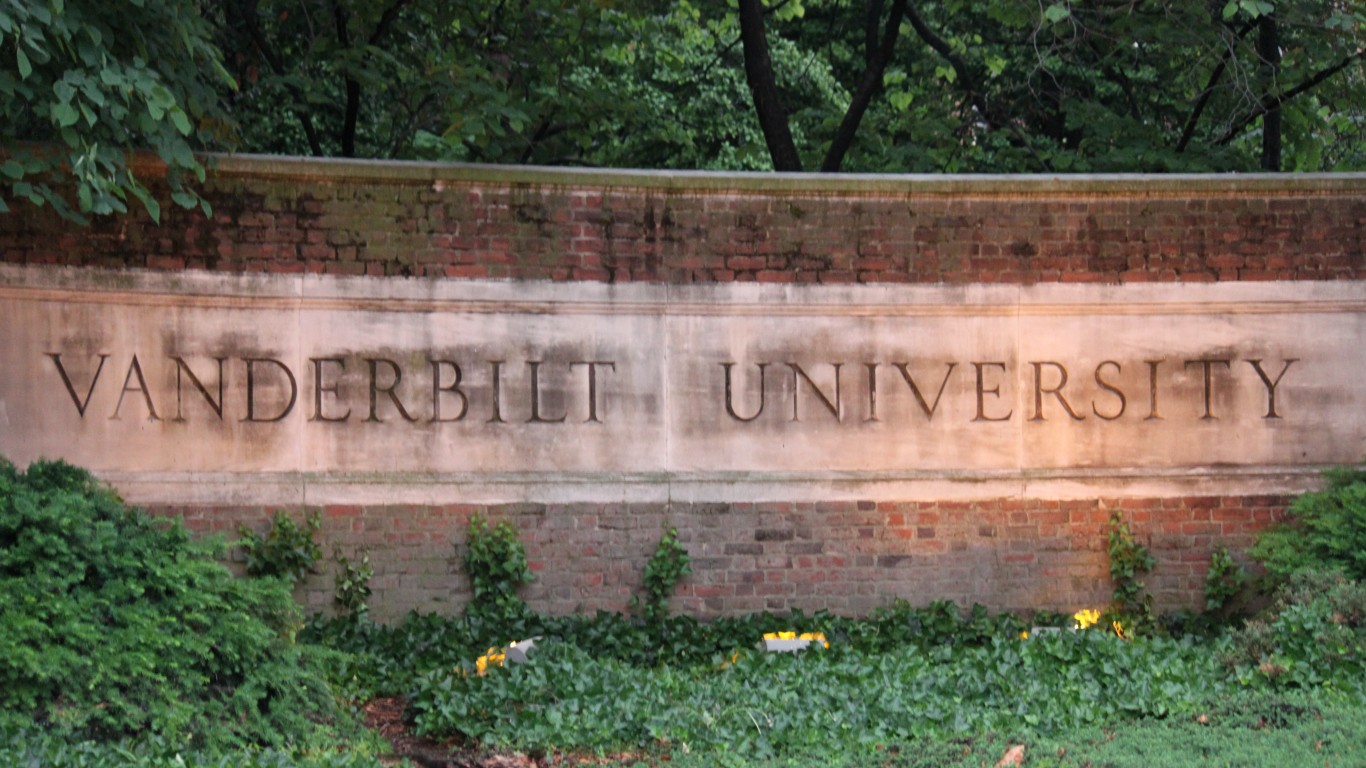
Tennessee: Vanderbilt University
> Location: Nashville
> Acceptance rate for 2019-2020: 9.1%
> Applicants for 2019-2020: 37,310
> Median SAT score: 1505 out of 1600
> Avg. annual cost of attendance: $67,392
> Four-year undergraduate enrollment, fall 2018: 6,840
Vanderbilt University owes its origins to railroad mogul Cornelius Vanderbilt, who gave $1 million to the university in 1873. Vanderbilt, one of the South’s most prestigious schools, is known for its undergraduate pre-med program and medical school. Vanderbilt alumni former Vice President of the United States Al Gore and Bangladeshi social entrepreneur Muhammad Yunus each won the Nobel Peace Prize in 2007 and 2006, respectively.

Texas: Rice University
> Location: Houston
> Acceptance rate for 2019-2020: 8.7%
> Applicants for 2019-2020: 27,087
> Median SAT score: 1505 out of 1600
> Avg. annual cost of attendance: $63,158
> Four-year undergraduate enrollment, fall 2018: 3,962
Rice University in Houston ranks as the most difficult school to get into in Texas and the 10th most difficult in the entire country when considering both acceptance rate and median SAT score. Rice is one of just 22 schools in the country with an acceptance rate below 10%. It also ranks in the top to American universities for median SAT score, at 1505 out of 1600. The school is known for its engineering and data science programs

Utah: Brigham Young University-Provo
> Location: Provo
> Acceptance rate for 2019-2020: 67.5%
> Applicants for 2019-2020: 10,500
> Median SAT score: 1305 out of 1600
> Avg. annual cost of attendance: $18,136
> Four-year undergraduate enrollment, fall 2018: 31,441
Brigham Young University was founded by the Mormon Church in 1875. Students are asked to adhere to its “honor code” that requires abstinence from drugs, alcohol, tobacco, coffee, tea, and what the church views as “inappropriate” sexual activity, such as sex outside of marriage. BYU ranks as one of the hardest schools to get into in large part because its median SAT score is 1305, which ranks in the top 20 among all universities considered for this list.
[in-text-ad-2]

Vermont: Middlebury College
> Location: Middlebury
> Acceptance rate for 2019-2020: 15.4%
> Applicants for 2019-2020: 9,754
> Median SAT score: 1415 out of 1600
> Avg. annual cost of attendance: $69,464
> Four-year undergraduate enrollment, fall 2018: 2,550
Middlebury College, founded in 1800, is regarded as one of the most rigorous small private liberal arts colleges in the U.S. The college emphasizes writing for all students, which the school says “sharpens students’ capacity for critical thinking and expression.” The school’s low acceptance rate of 15.4% and its high median SAT score of 1415 make it one of the most difficult schools to get into in the country and the most exclusive in Vermont.
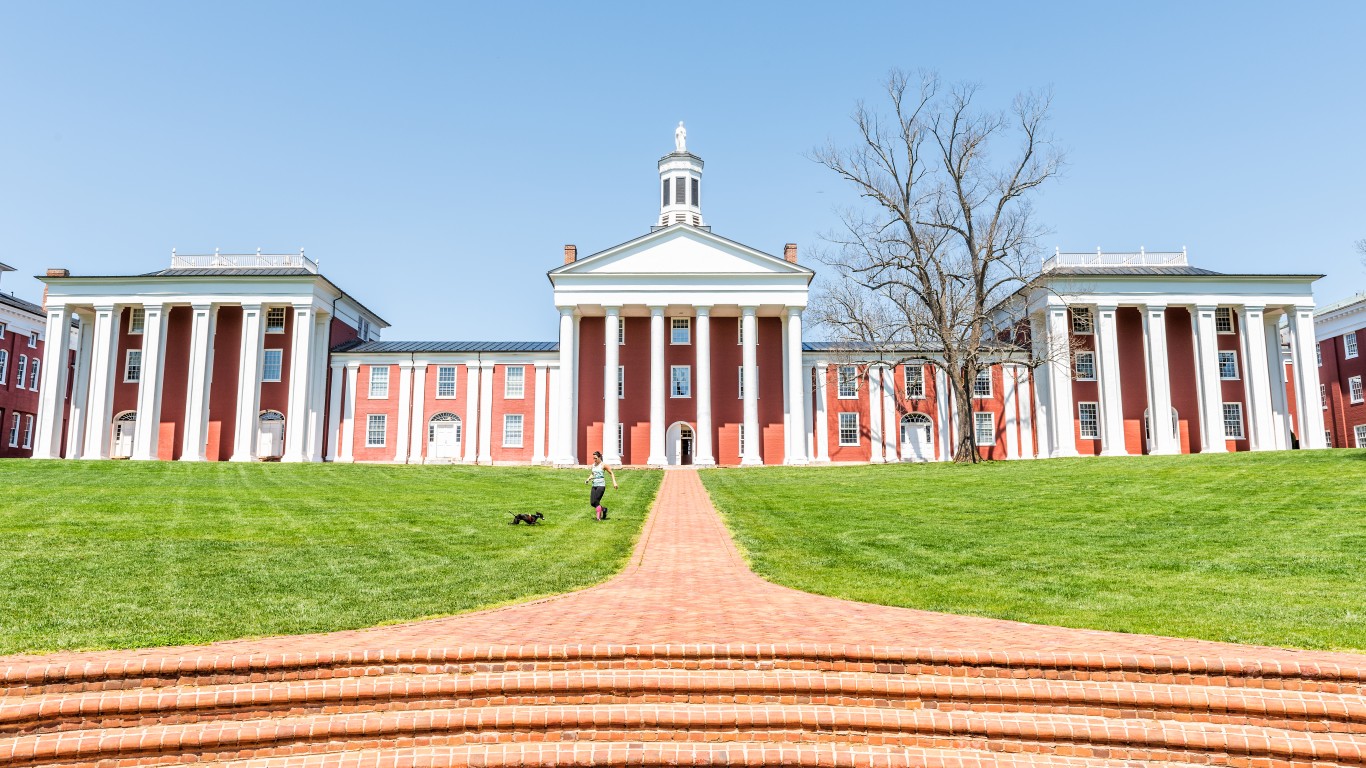
Virginia: Washington and Lee University
> Location: Lexington
> Acceptance rate for 2019-2020: 18.6%
> Applicants for 2019-2020: 6,178
> Median SAT score: 1419 out of 1600
> Avg. annual cost of attendance: $67,150
> Four-year undergraduate enrollment, fall 2018: 1,822
Washington and Lee University, founded in 1749, was named after George Washington, who made an endowment to the school, and Confederate general Robert E. Lee, who became president of the college after the Civil War. Author Tom Wolfe and explorer Meriwether Lewis of the Lewis and Clark Expedition are among the school’s notable alumni. It is the only school in Virginia to accept fewer than 20% of applicants. In July 2020, school faculty members voted to remove “Lee” from the university’s name.
[in-text-ad]
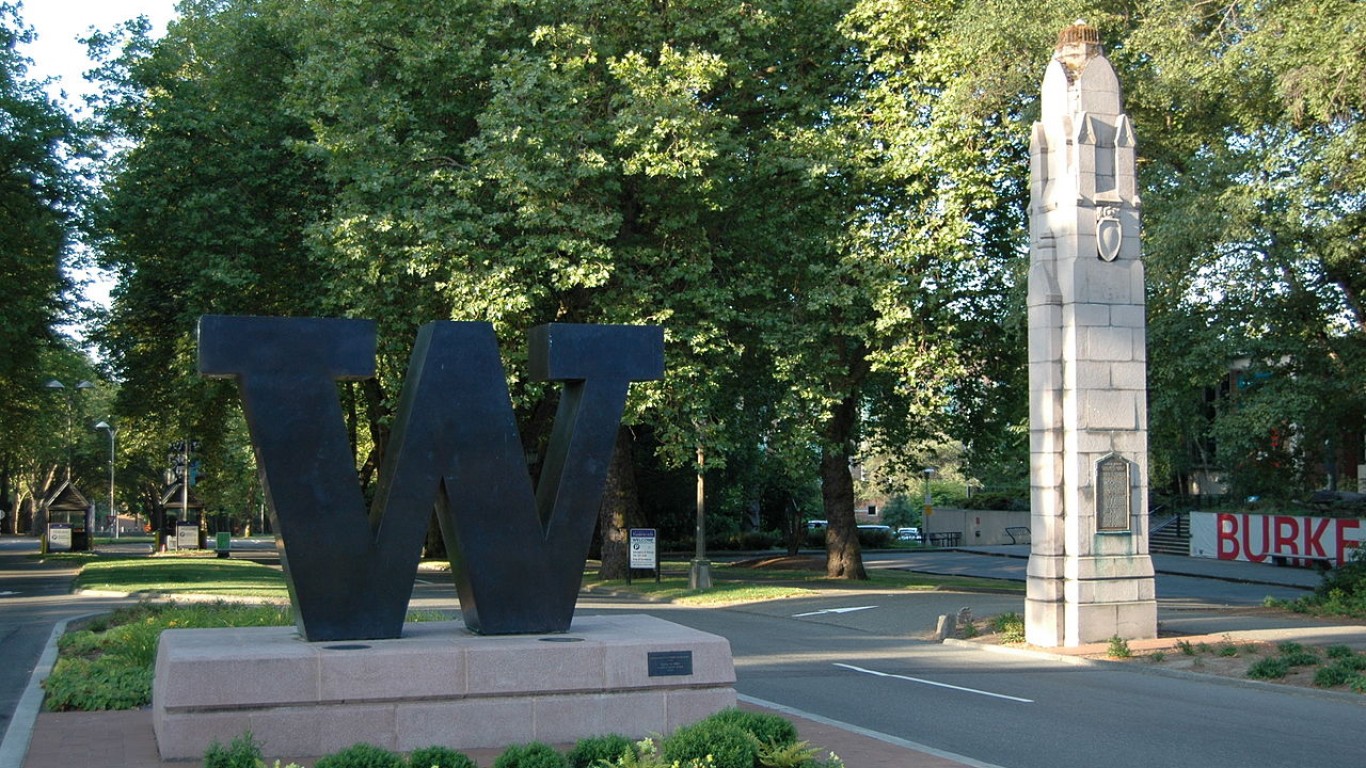
Washington: University of Washington-Seattle Campus
> Location: Seattle
> Acceptance rate for 2019-2020: 51.8%
> Applicants for 2019-2020: 45,579
> Median SAT score: 1340 out of 1600
> Avg. annual cost of attendance: $25,275
> Four-year undergraduate enrollment, fall 2018: 30,905
Founded in 1861, University of Washington is one of the oldest public universities in the western United States. It is one of the largest schools on the list, with an enrollment of nearly 31,000. The university’s main campus is in Seattle. There are two other campuses in Bothell and Tacoma.

West Virginia: West Virginia University Institute of Technology
> Location: Beckley
> Acceptance rate for 2019-2020: 51.1%
> Applicants for 2019-2020: 1,245
> Median SAT score: 1105 out of 1600
> Avg. annual cost of attendance: $17,166
> Four-year undergraduate enrollment, fall 2018: 1,295
West Virginia University Institute of Technology is the least expensive college to rank as its state’s hardest college to get into. Its average cost of attendance is just over $17,000. The school offers 32 majors, including criminal justice, mechanical engineering, psychology, and more. WVU Tech ranks among the state’s best schools, with a 93.1% employment rate for students six years after entry, and a median income for working students 10 years after entry of $34,500.
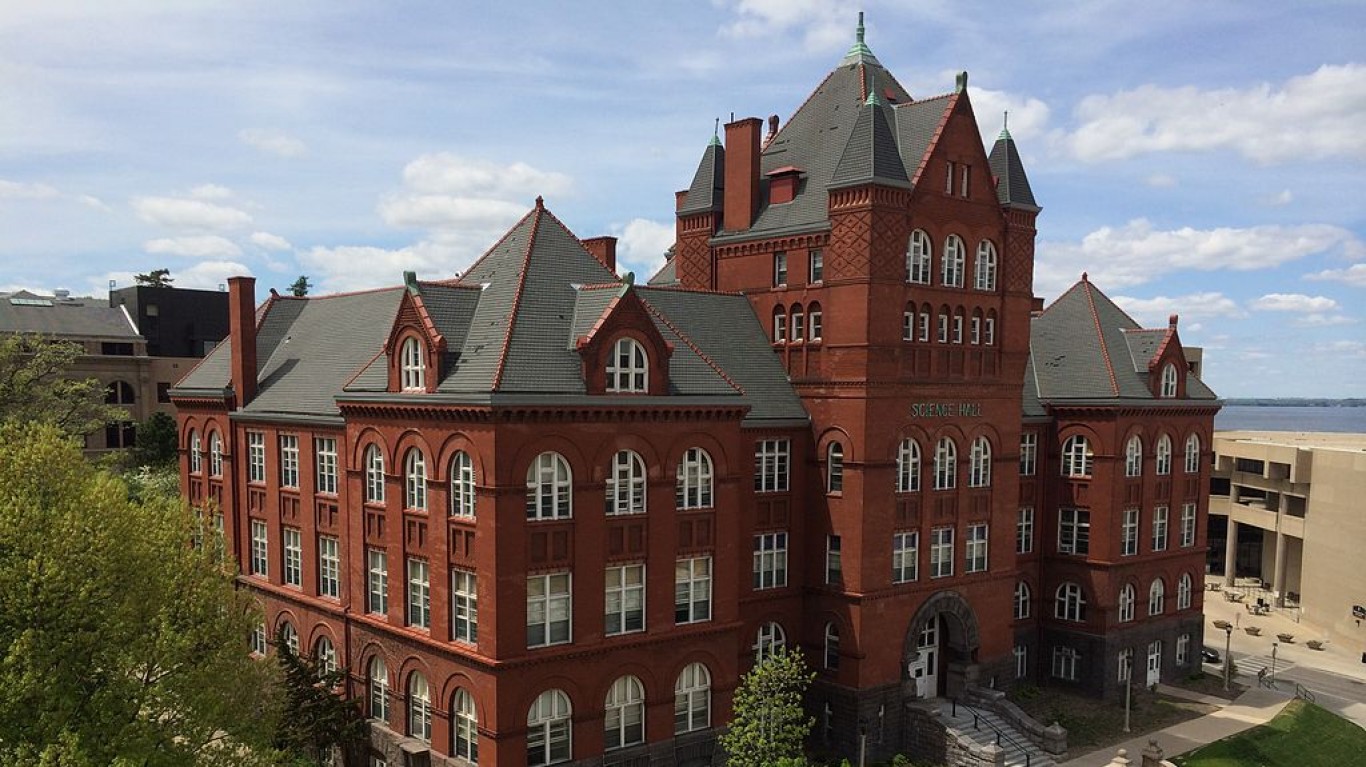
Wisconsin: University of Wisconsin-Madison
> Location: Madison
> Acceptance rate for 2019-2020: 54.4%
> Applicants for 2019-2020: 43,896
> Median SAT score: 1365 out of 1600
> Avg. annual cost of attendance: $25,497
> Four-year undergraduate enrollment, fall 2018: 30,360
The University of Wisconsin – Madison received nearly 44,000 applications for the 2019-2020 school year, 30th most among all American colleges. In part because of the high volume, its acceptance rate is just 54.4%, lower than all other Wisconsin colleges. Twenty alumni have won a Nobel Prize. Novelist Joyce Carol Oates, progressive politician Robert M. La Follette, and architect Frank Lloyd Wright are among the school’s alumni.
[in-text-ad-2]
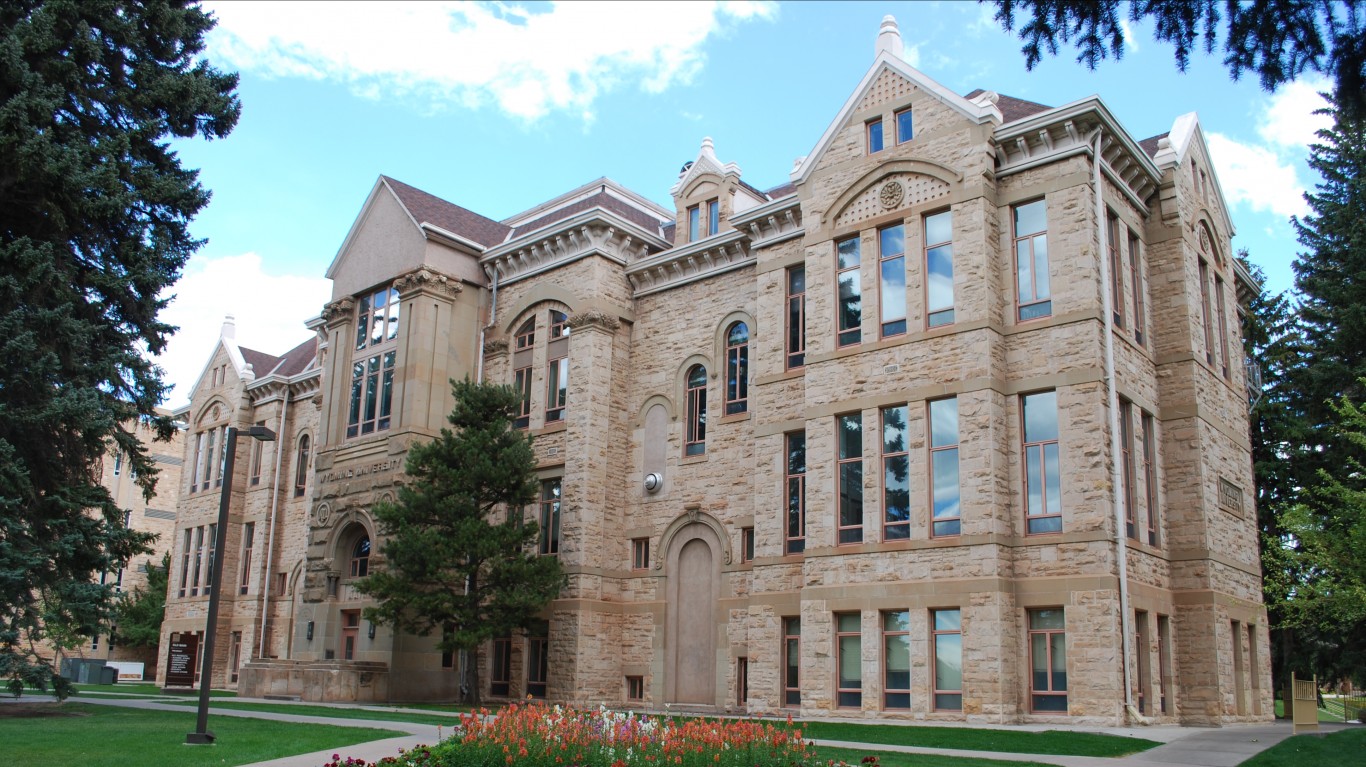
Wyoming: University of Wyoming
> Location: Laramie
> Acceptance rate for 2019-2020: 96.0%
> Applicants for 2019-2020: 5,348
> Median SAT score: 1165 out of 1600
> Avg. annual cost of attendance: $19,777
> Four-year undergraduate enrollment, fall 2018: 9,854
The University of Wyoming is the only college in the state for which data on acceptance rate and median SAT score were available, making it the hardest college in the state to get into by default. The school’s 96% acceptance rate is by far the highest of any college on this list. The University of Wyoming offers students 80 fields of study, including agriculture, business, law, education, and more.
Methodology
To determine the hardest colleges to get into by state, 24/7 Wall St. reviewed data on admissions and SAT scores from the National Center for Education Statistics of the U.S. Department of Education. Colleges and universities were ranked based on an index comprising admission rates for the 2019-2020 school year and the median combined math and critical reading SAT scores for students admitted in fall 2018. Supplemental data on the average cost of attendance for the 2017-2018 school year also came from the NCES. Additional information was found in the Princeton Review as well as college websites.
We only considered predominantly bachelor’s degree-granting colleges and universities with at least 1,000 applicants. In Wyoming, there was only one school with at least 1,000 applicants, and so the school listed in Wyoming is the hardest to get into by default. Enrollment figures are for all undergraduates, both full- and part-time, for fall 2018, also from the NCES.
The thought of burdening your family with a financial disaster is most Americans’ nightmare. However, recent studies show that over 100 million Americans still don’t have proper life insurance in the event they pass away.
Life insurance can bring peace of mind – ensuring your loved ones are safeguarded against unforeseen expenses and debts. With premiums often lower than expected and a variety of plans tailored to different life stages and health conditions, securing a policy is more accessible than ever.
A quick, no-obligation quote can provide valuable insight into what’s available and what might best suit your family’s needs. Life insurance is a simple step you can take today to help secure peace of mind for your loved ones tomorrow.
Click here to learn how to get a quote in just a few minutes.
Thank you for reading! Have some feedback for us?
Contact the 24/7 Wall St. editorial team.